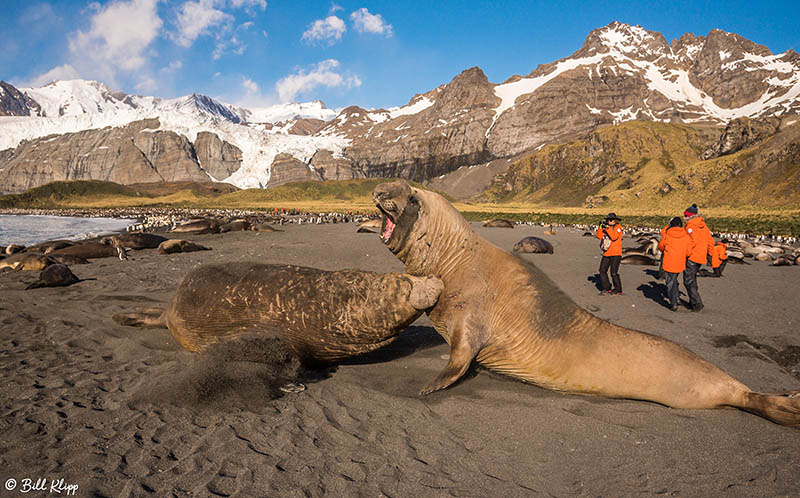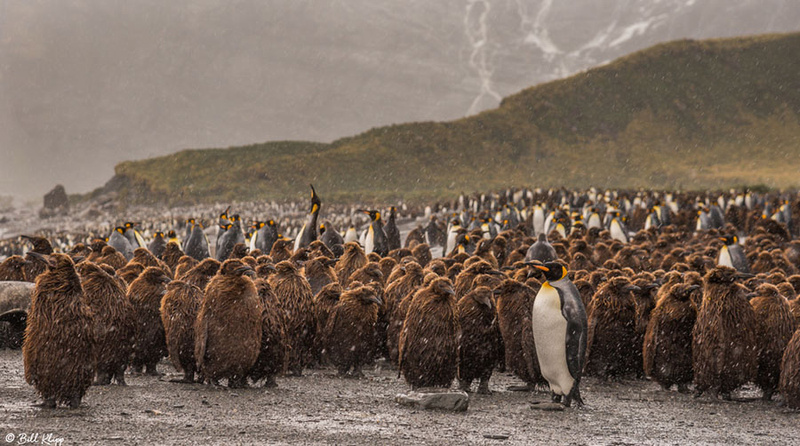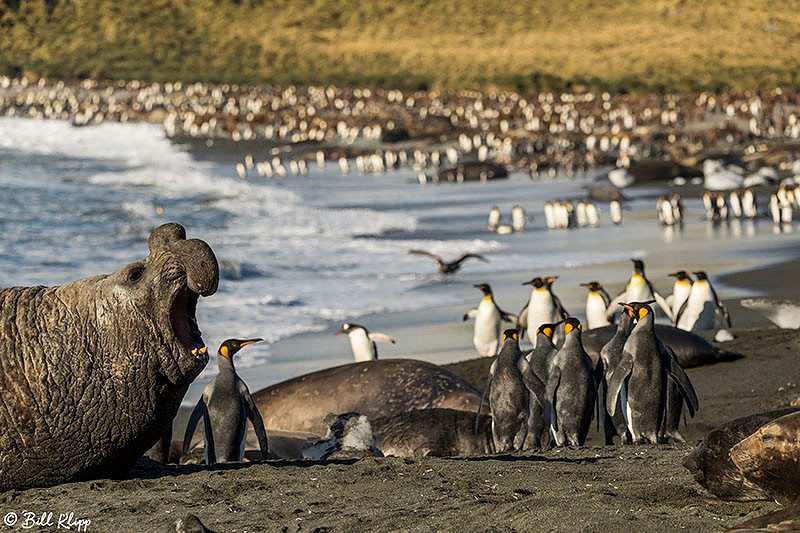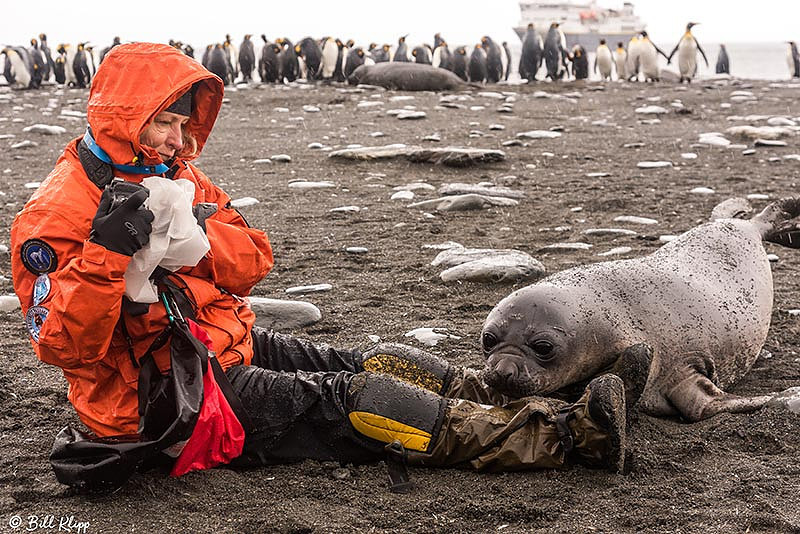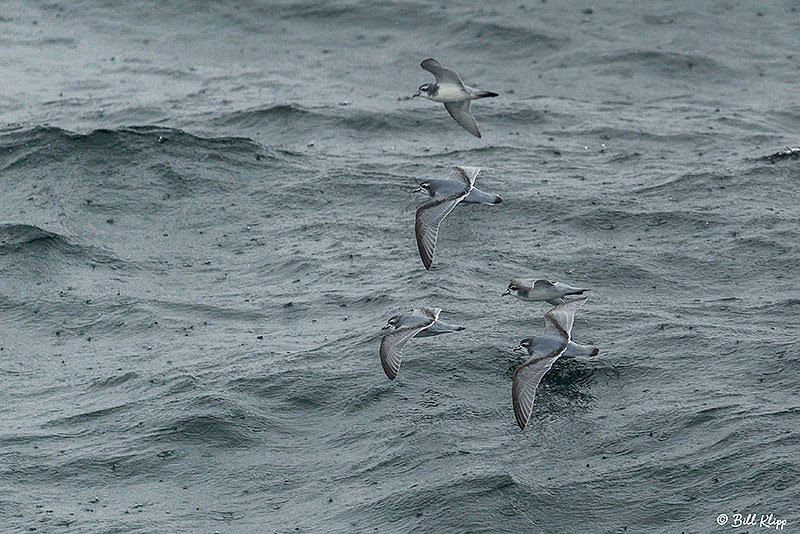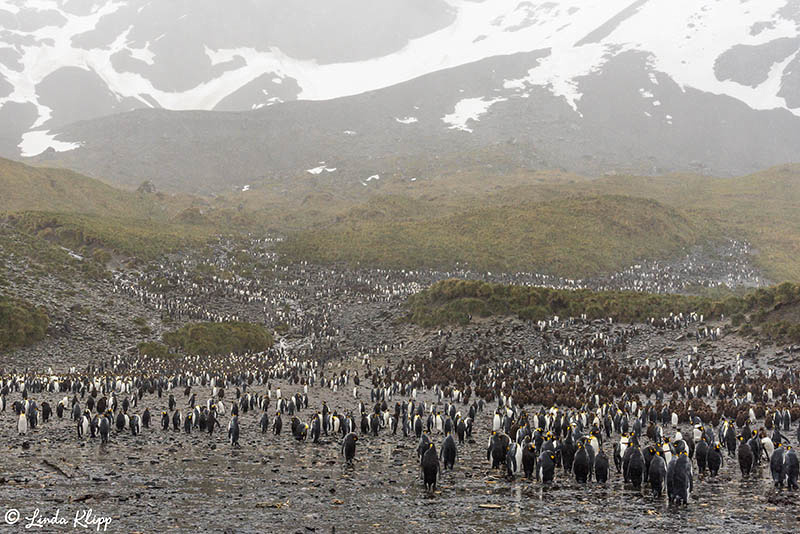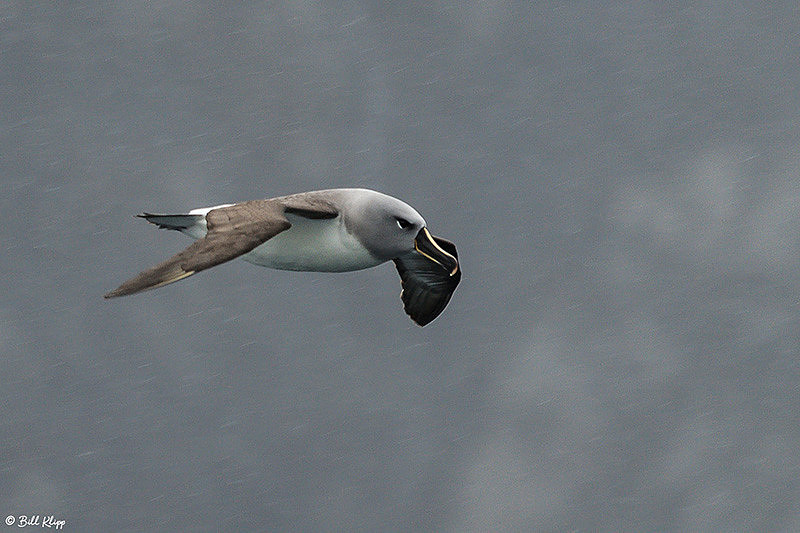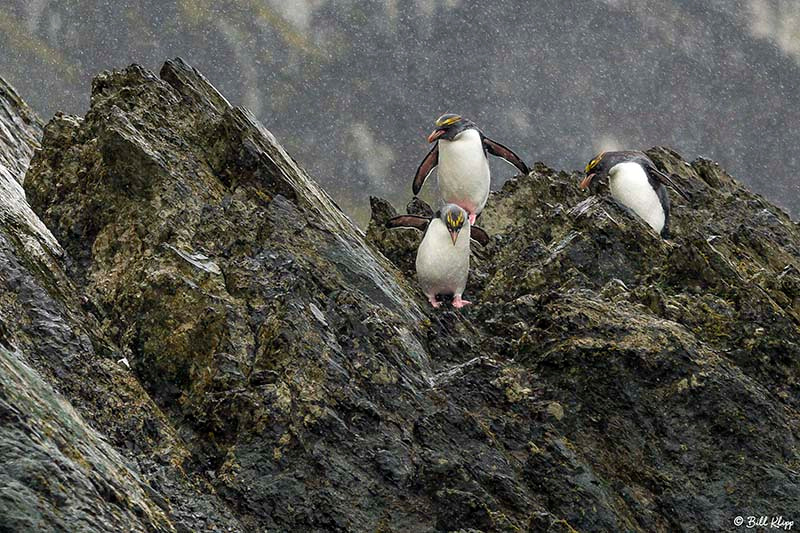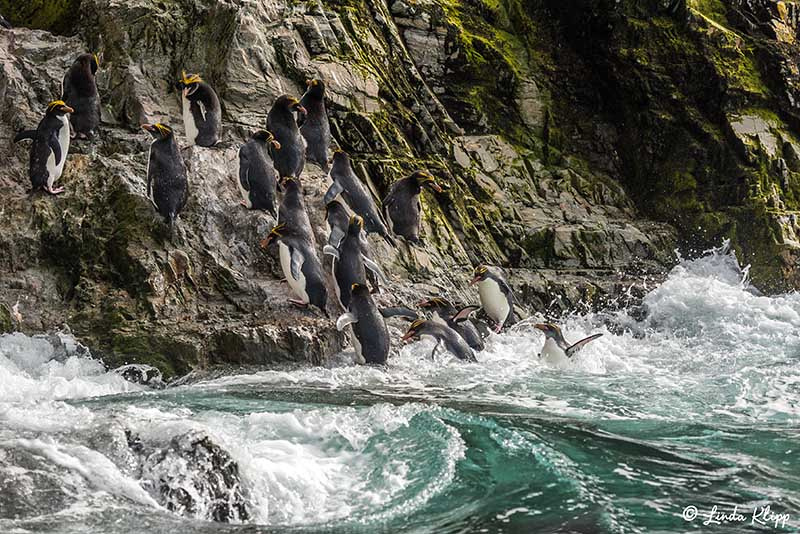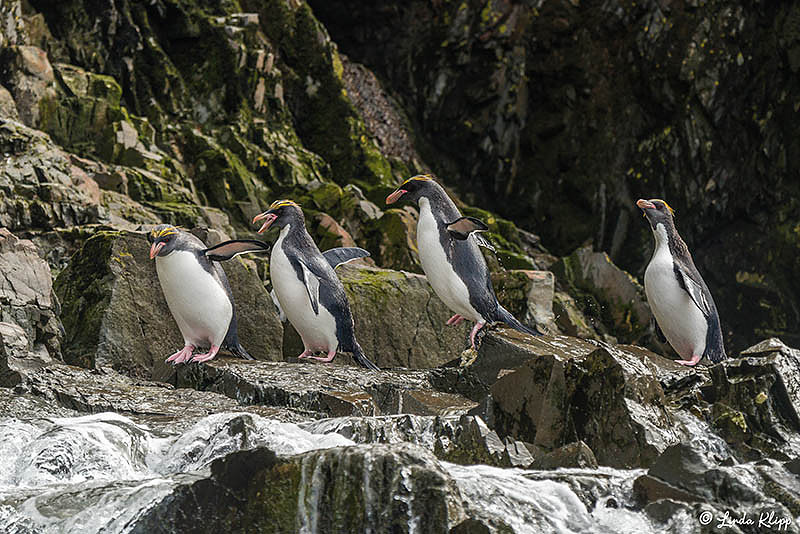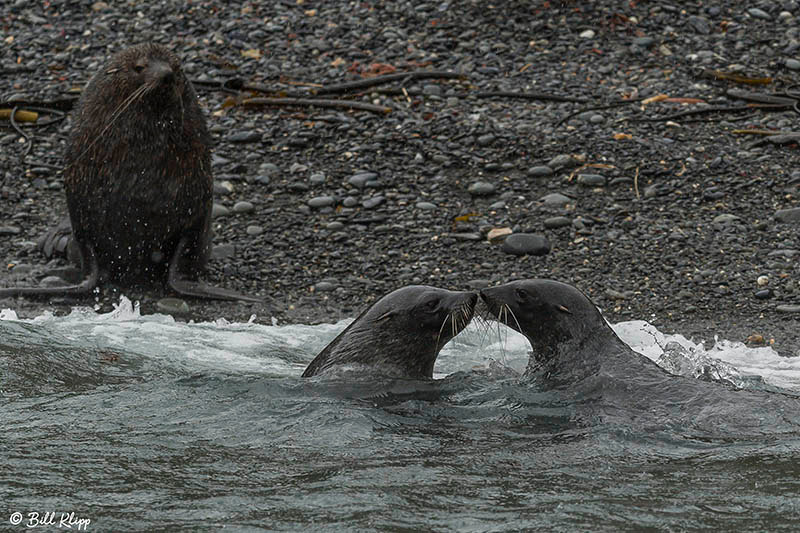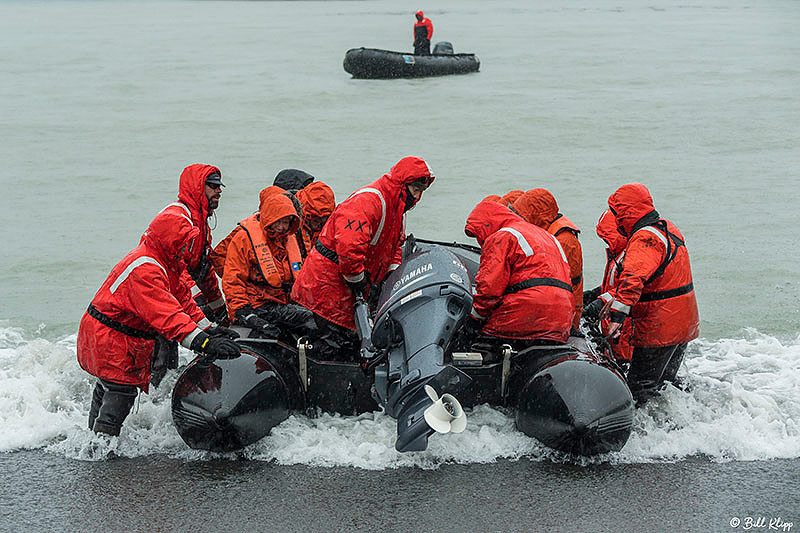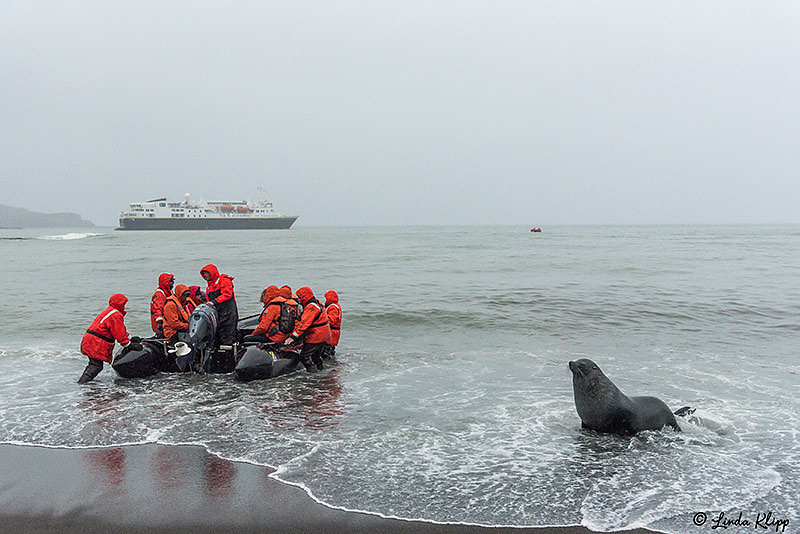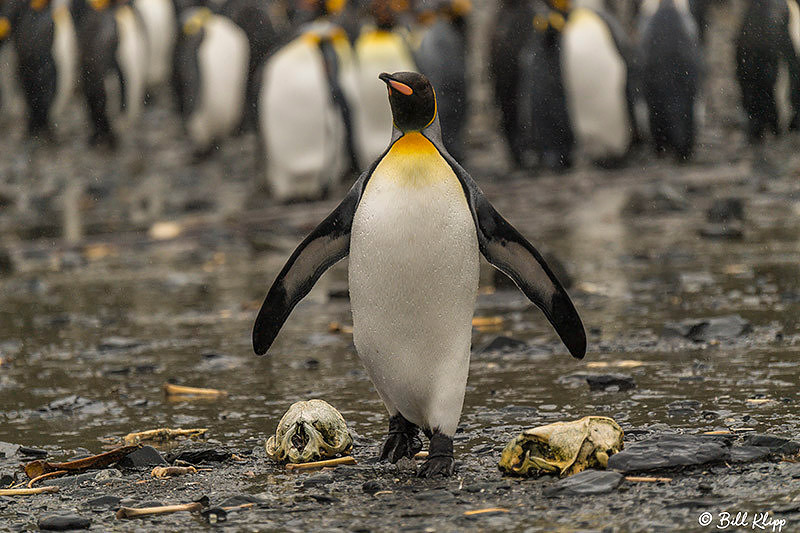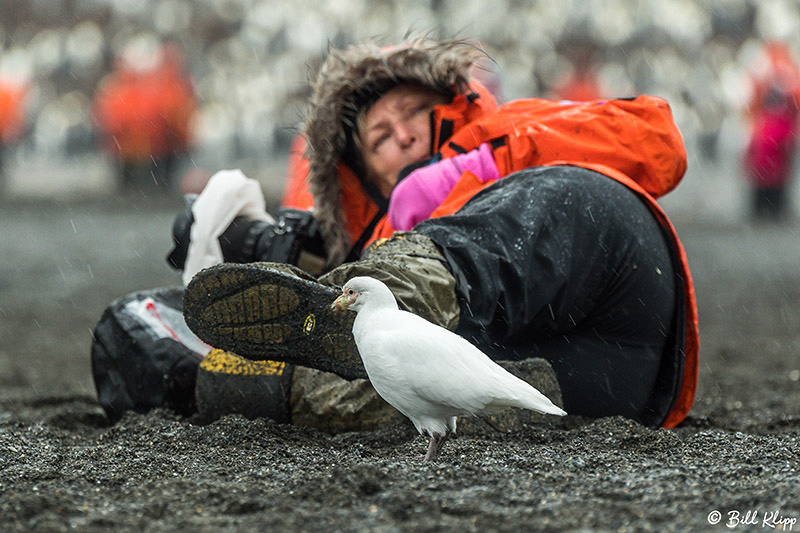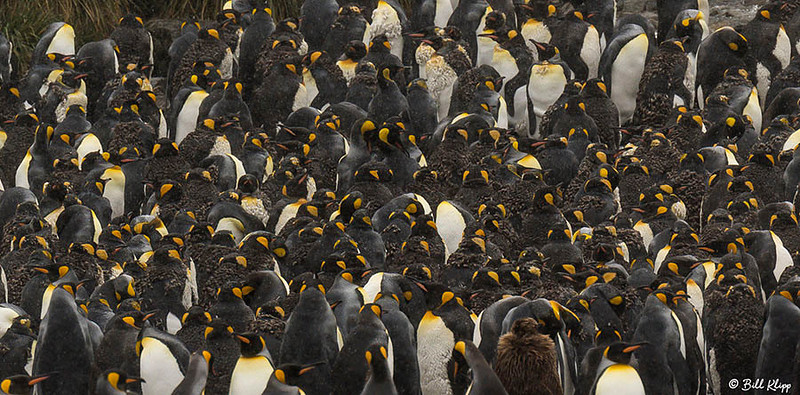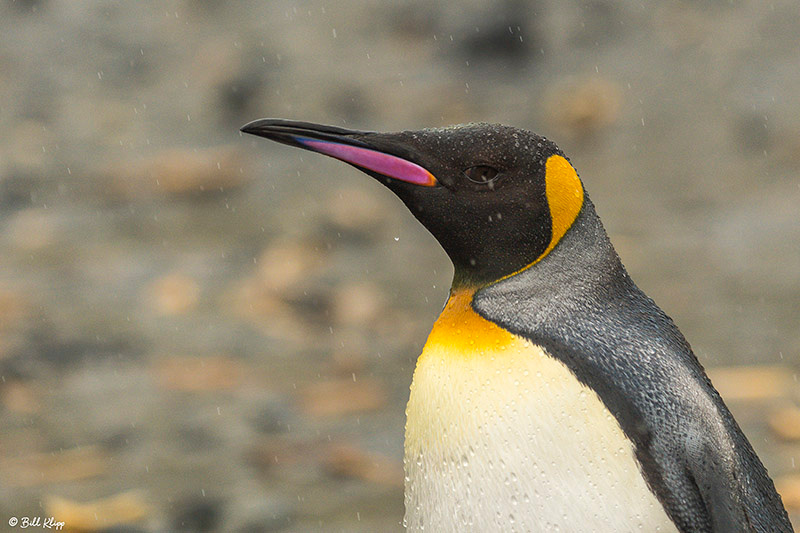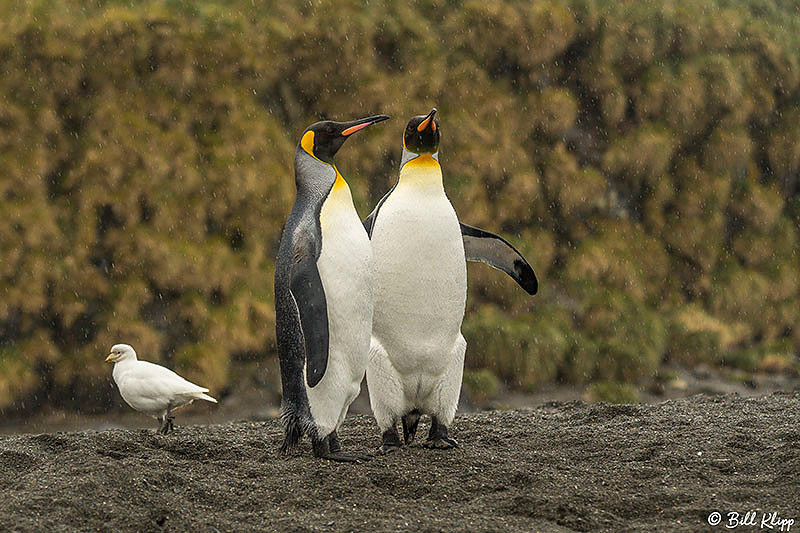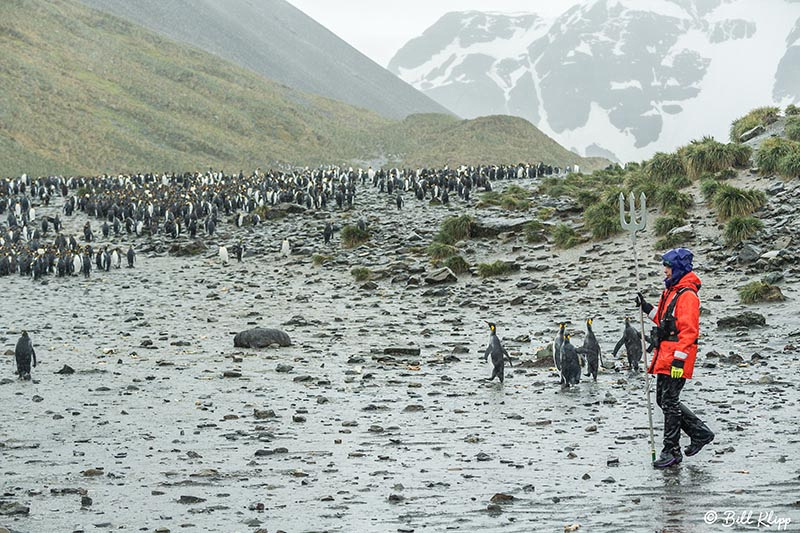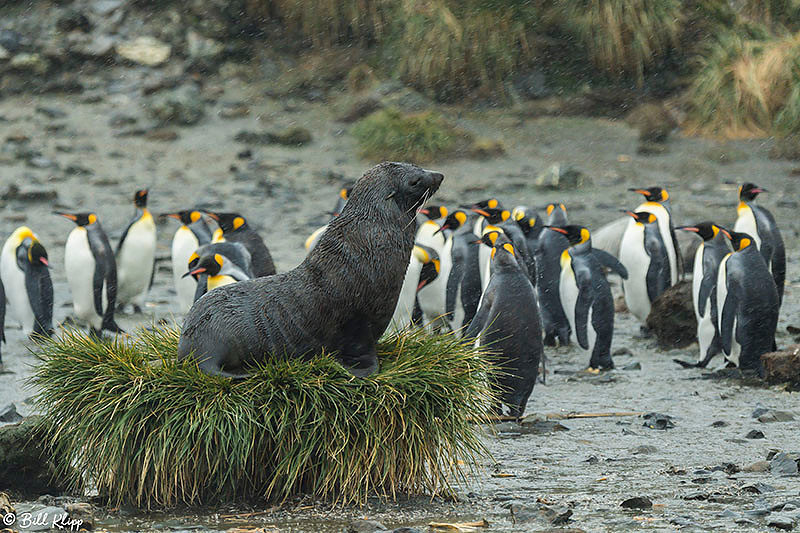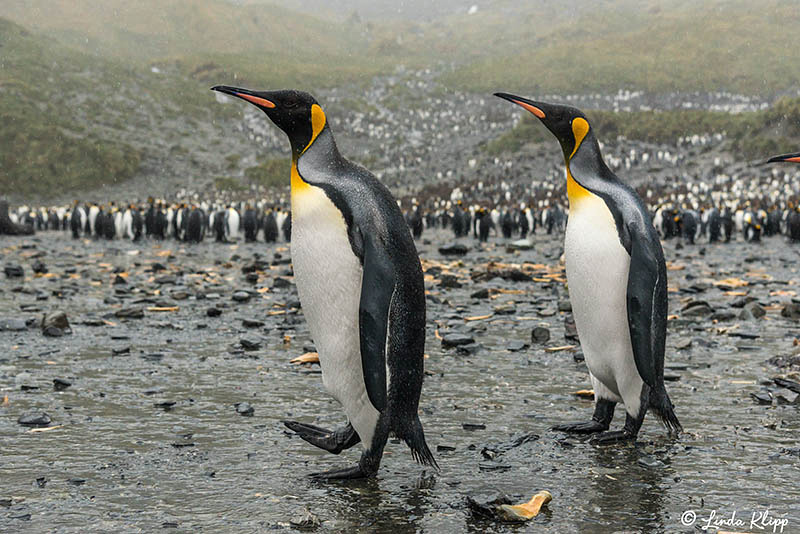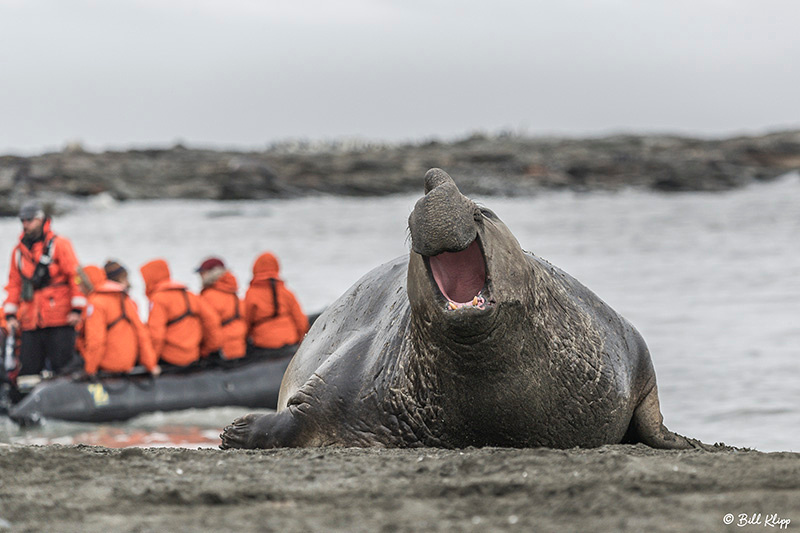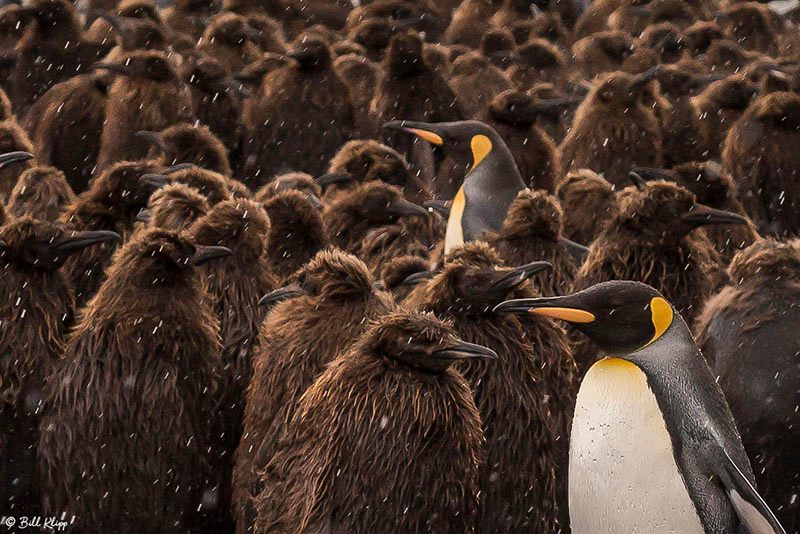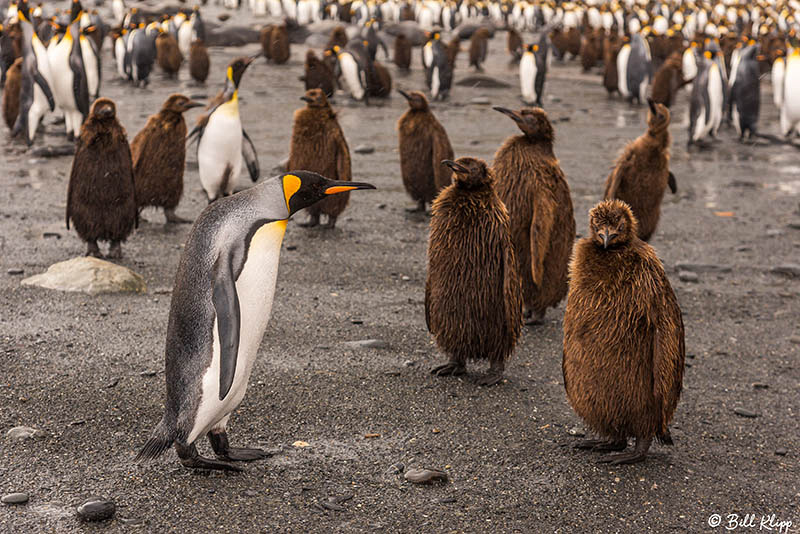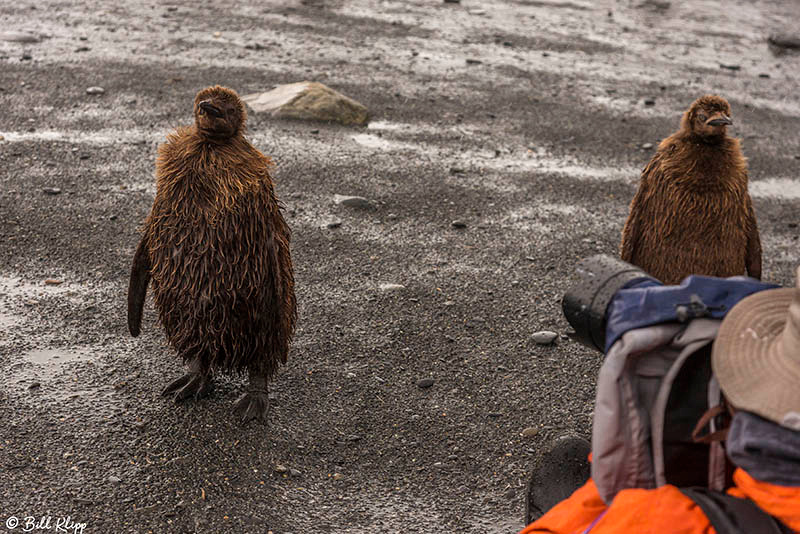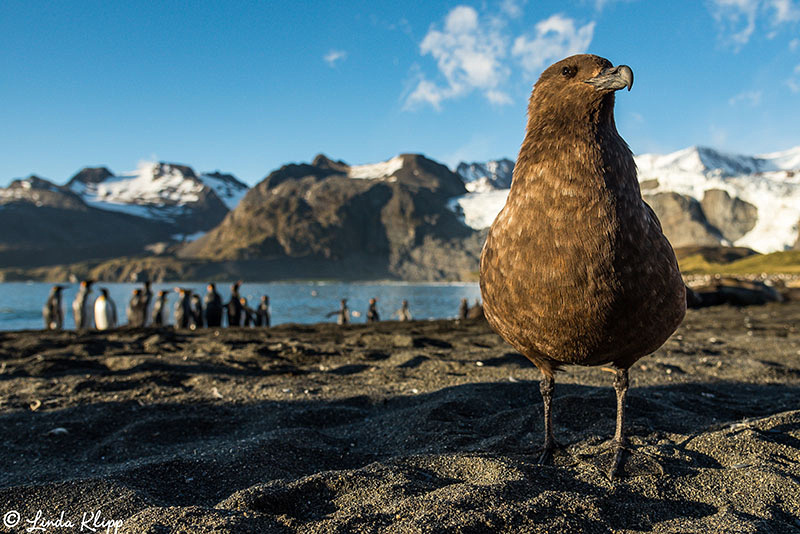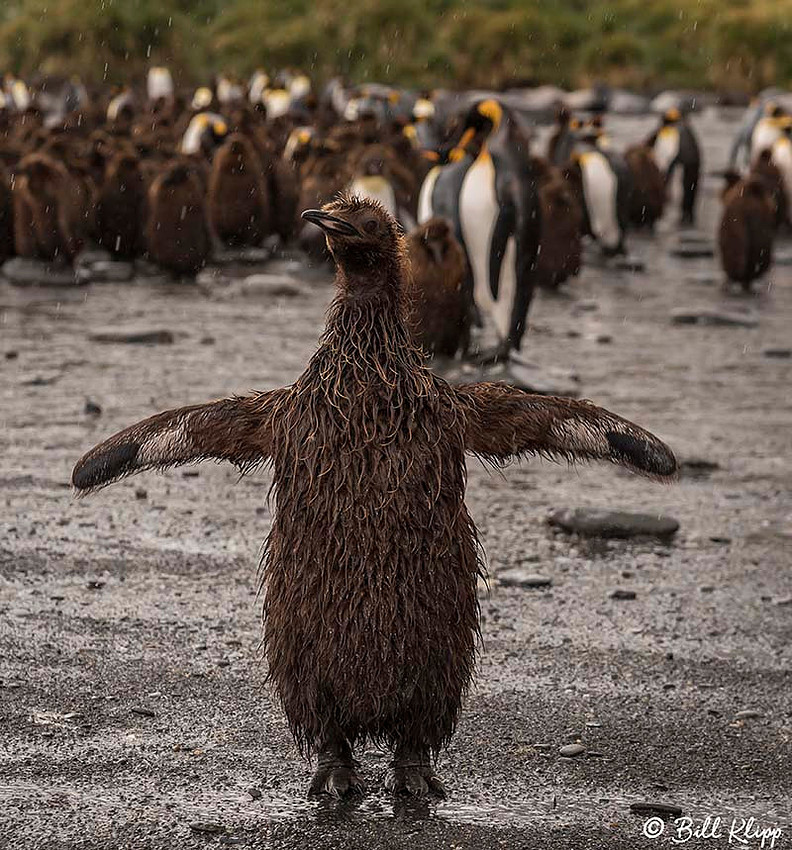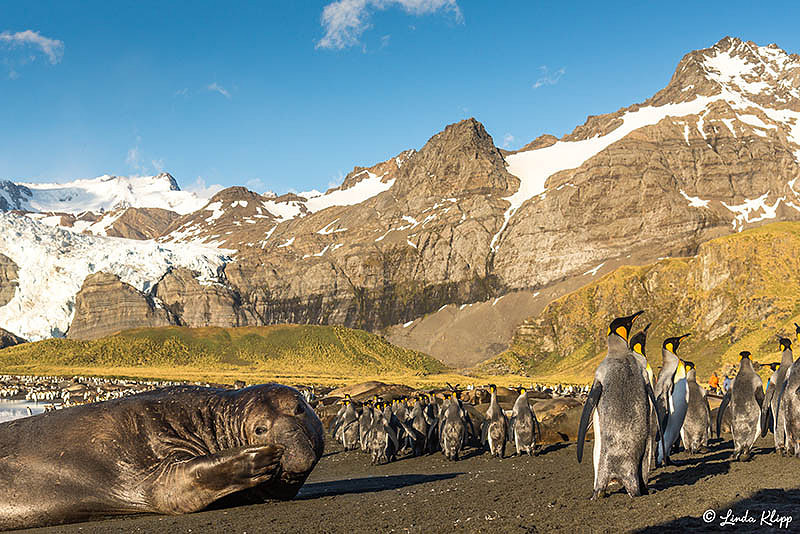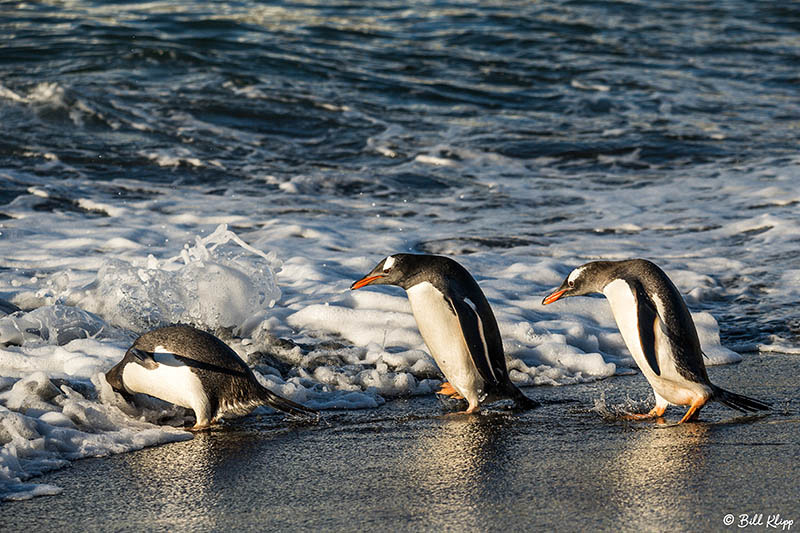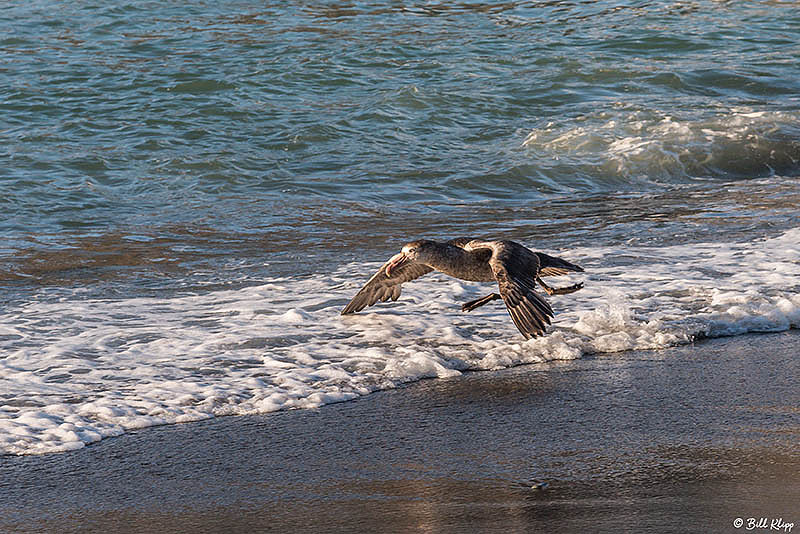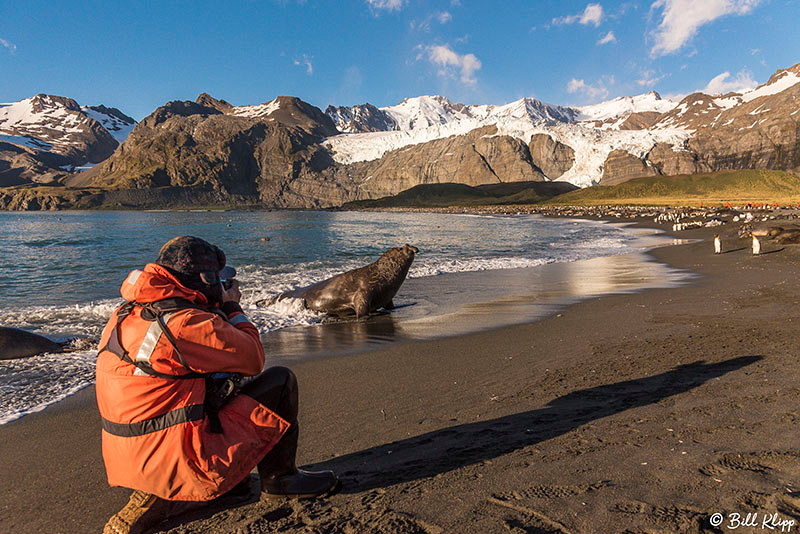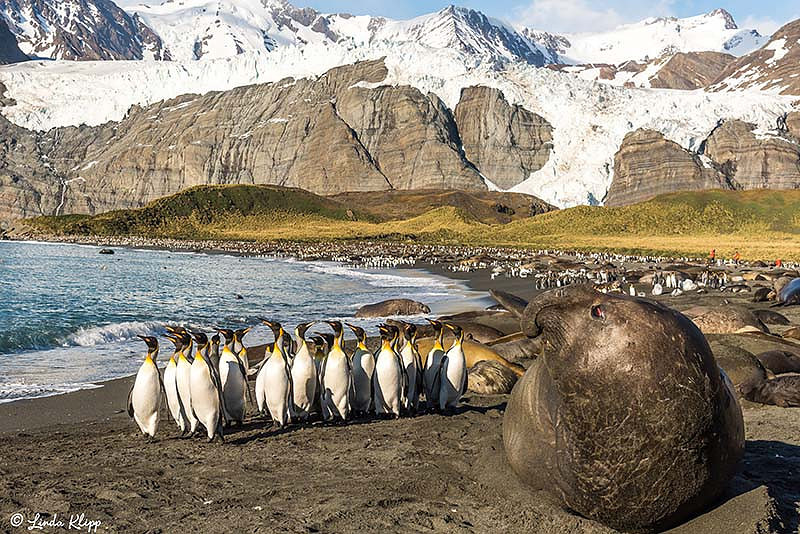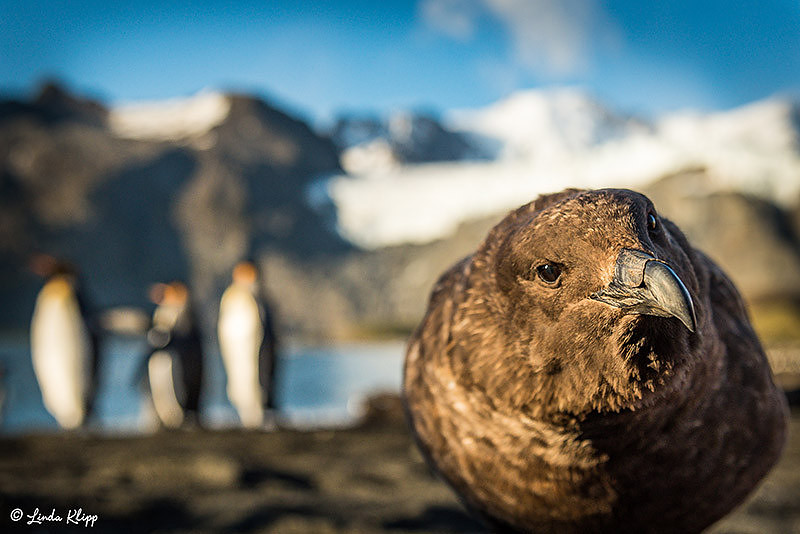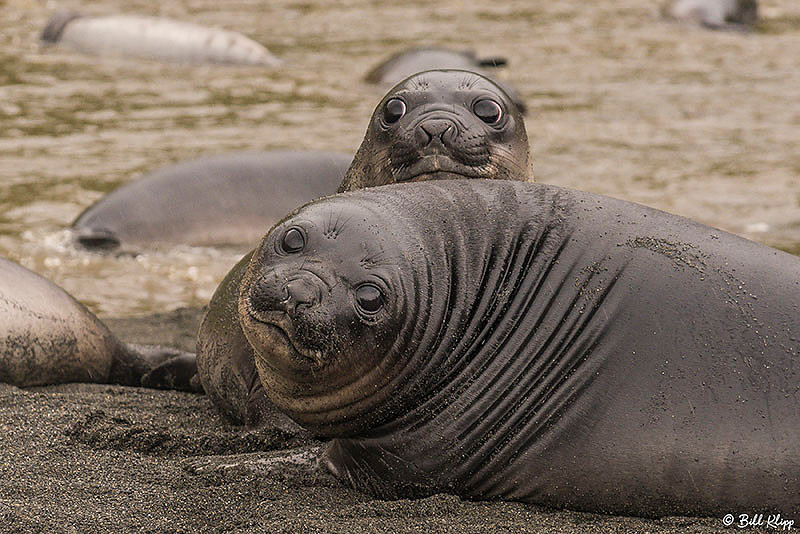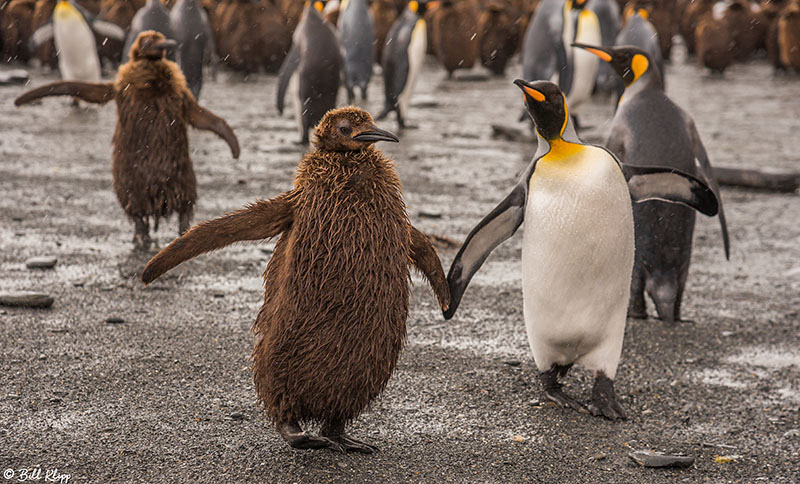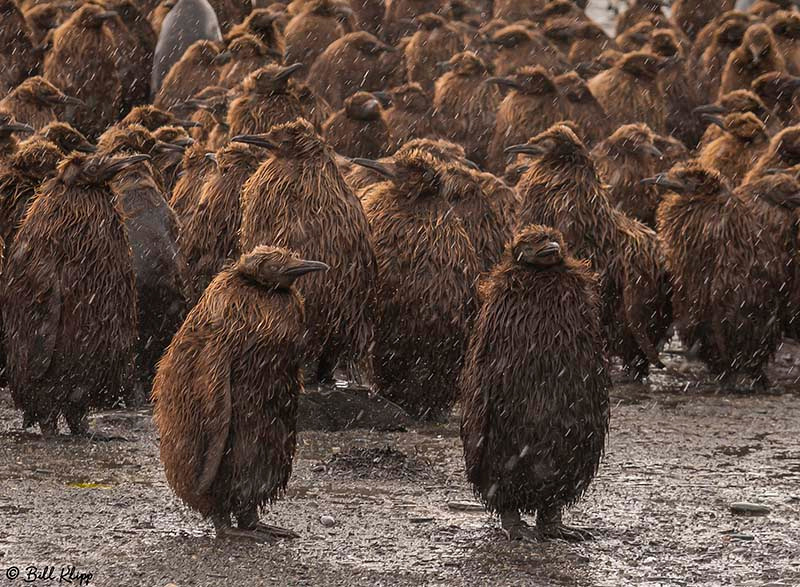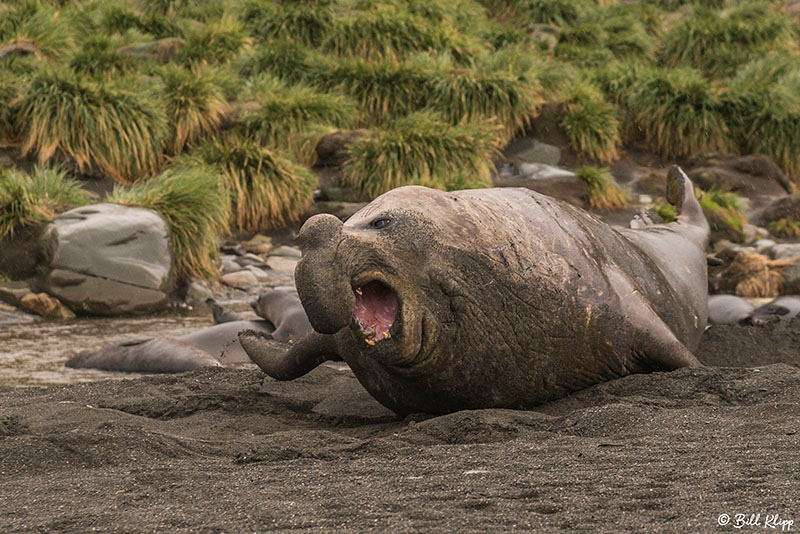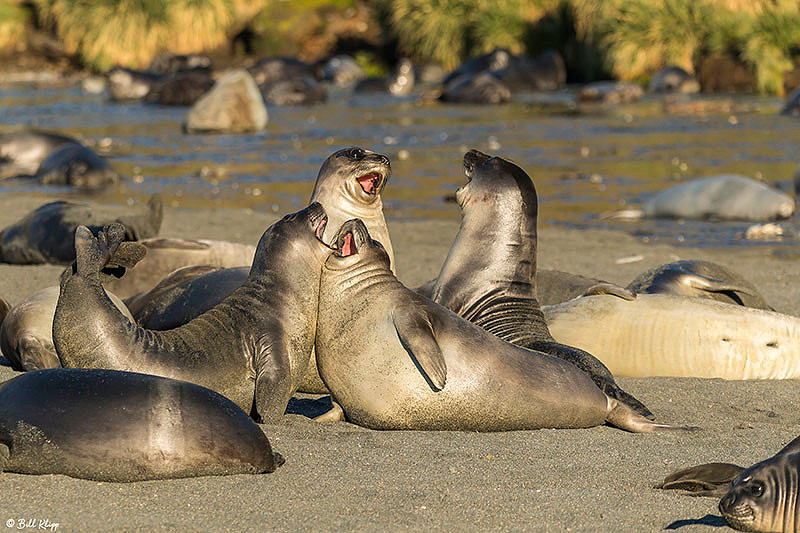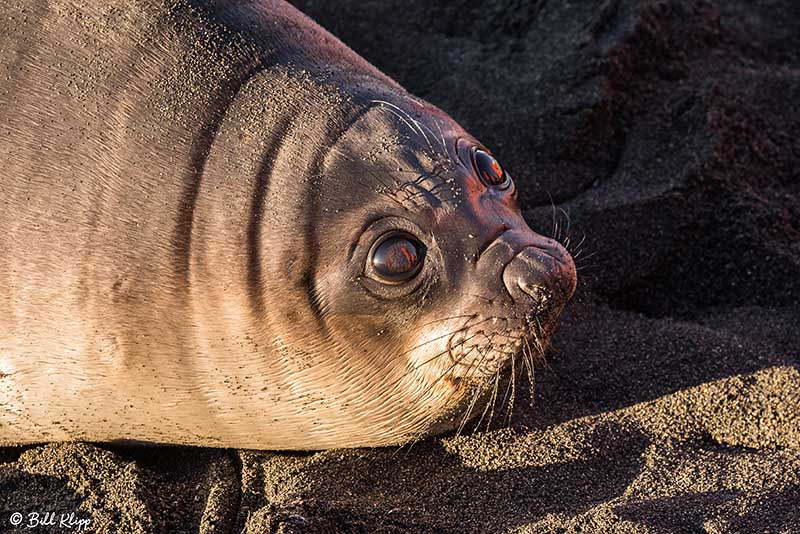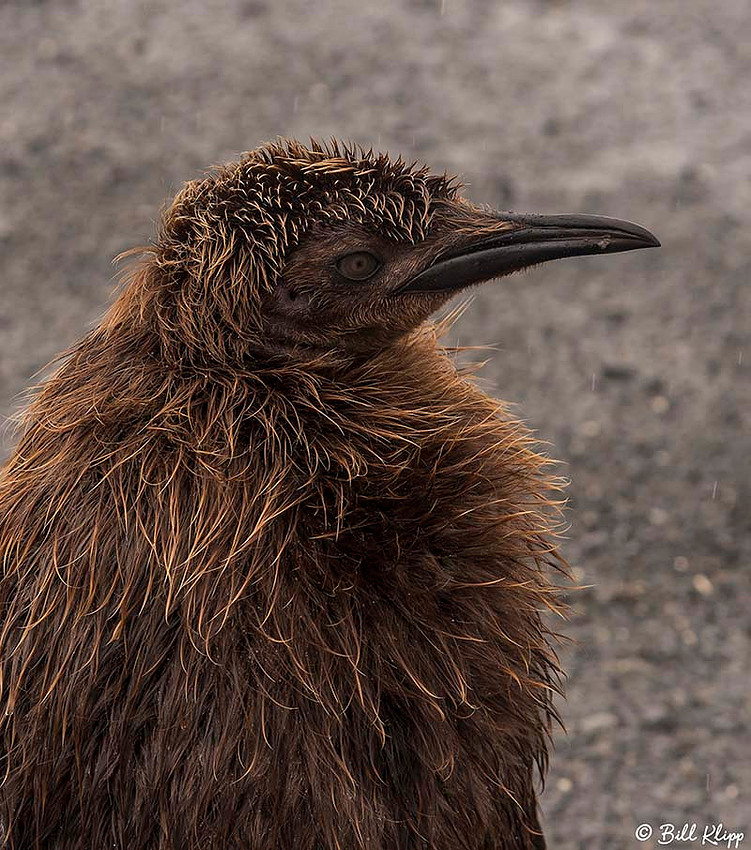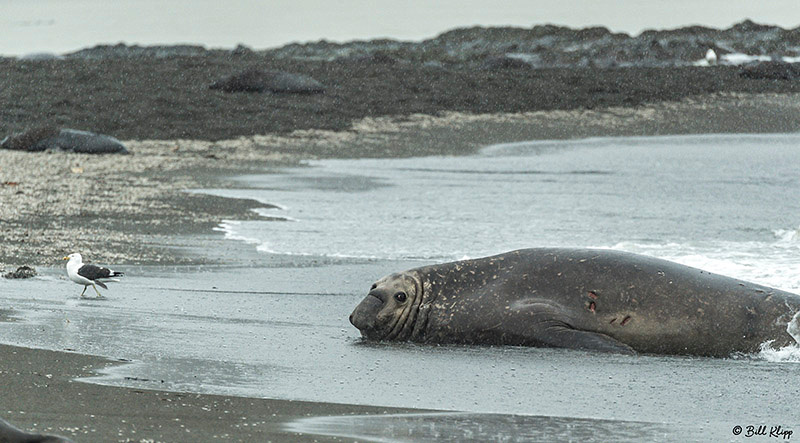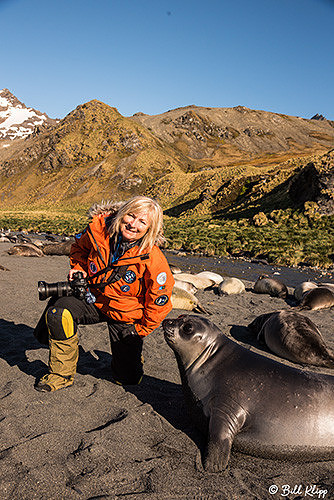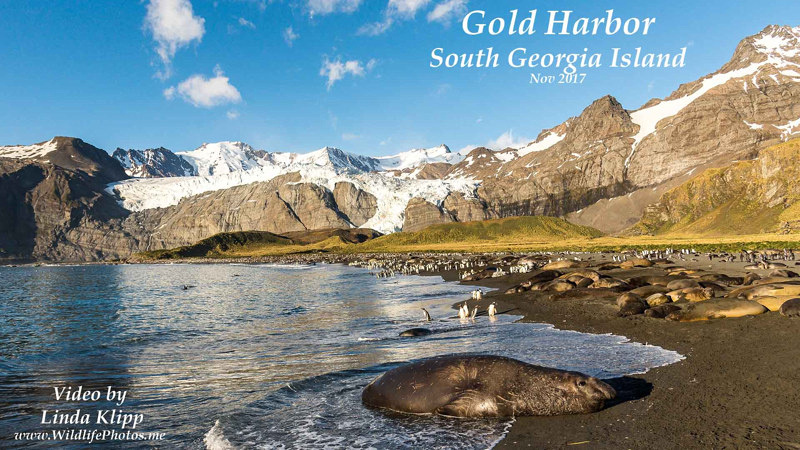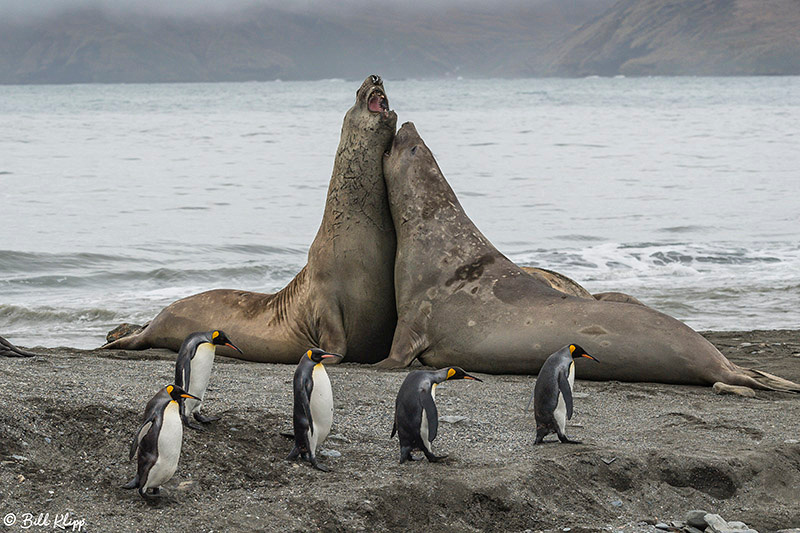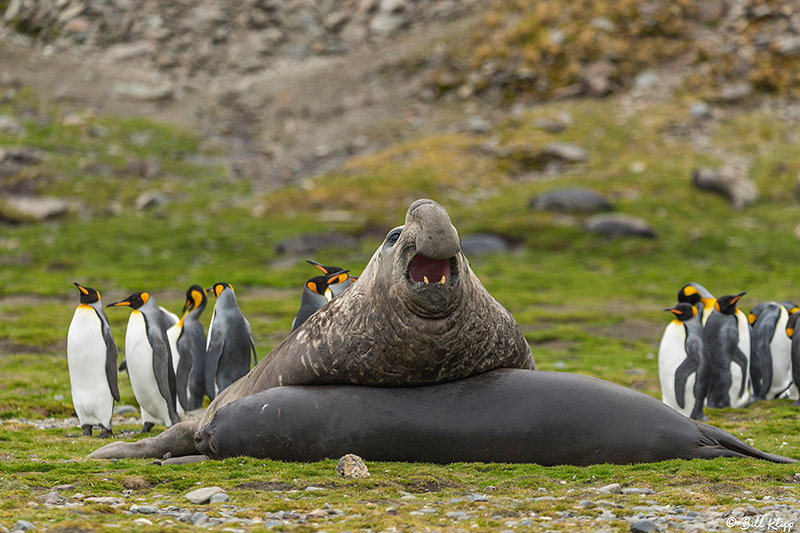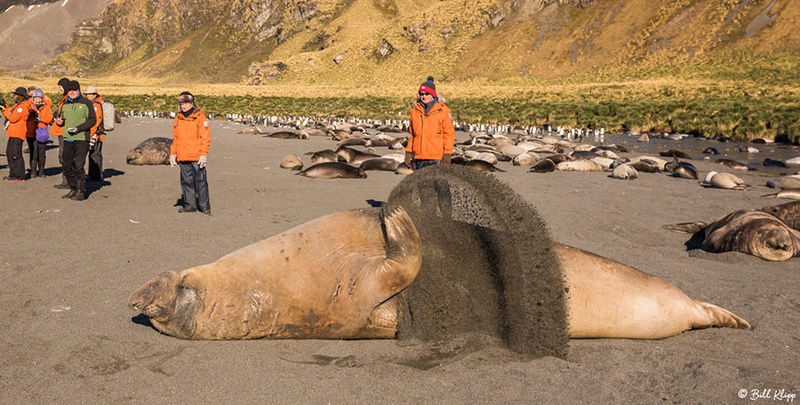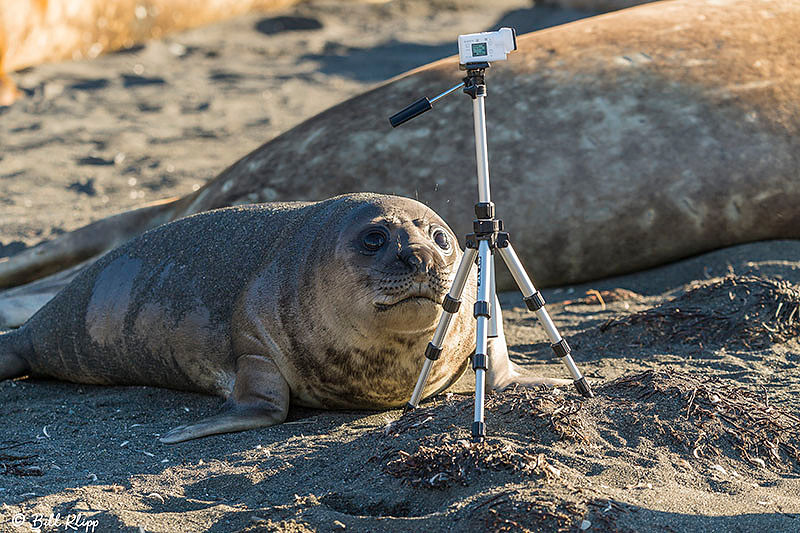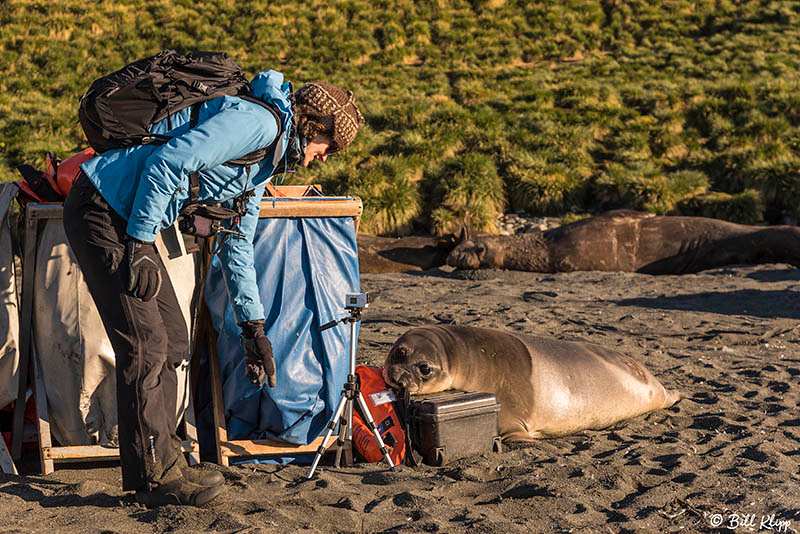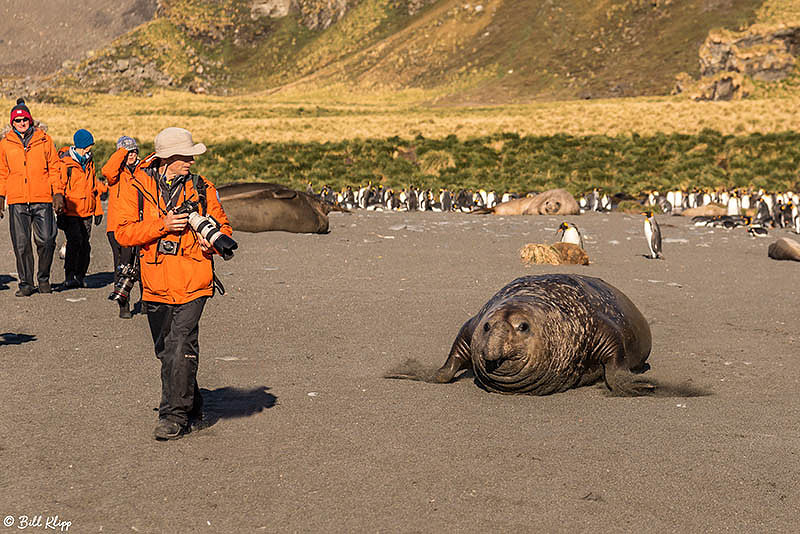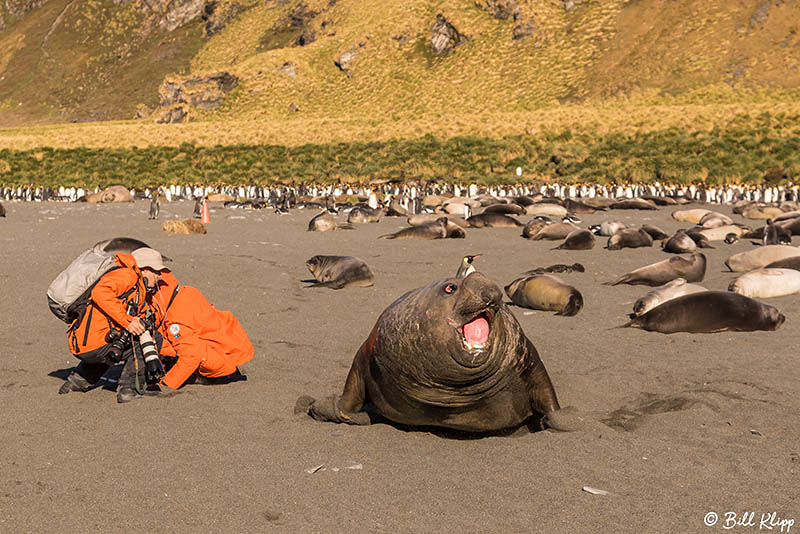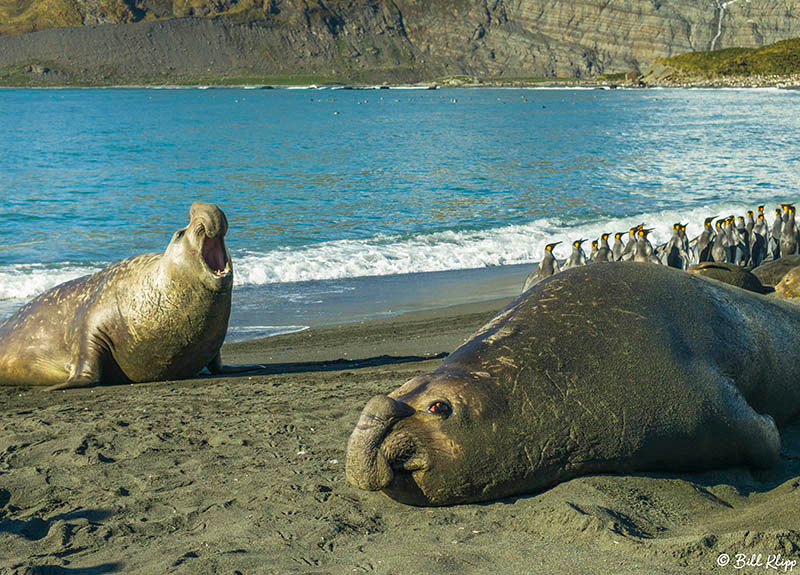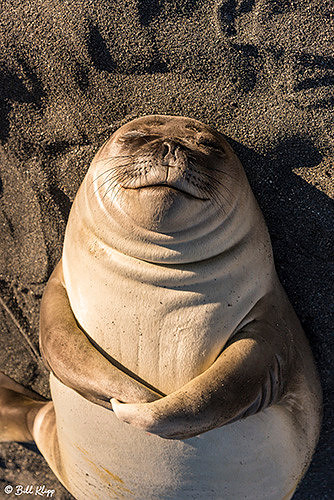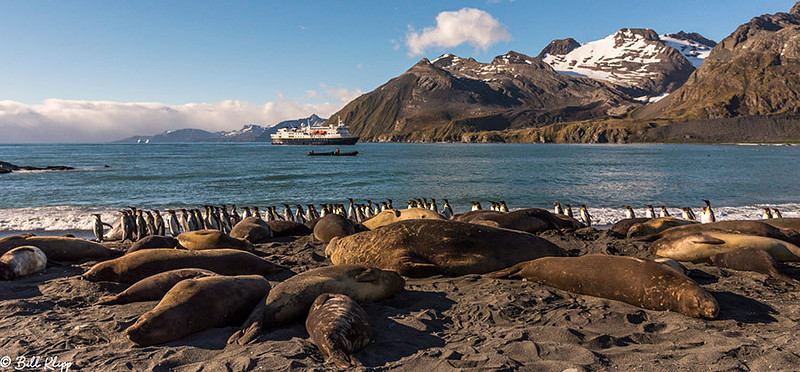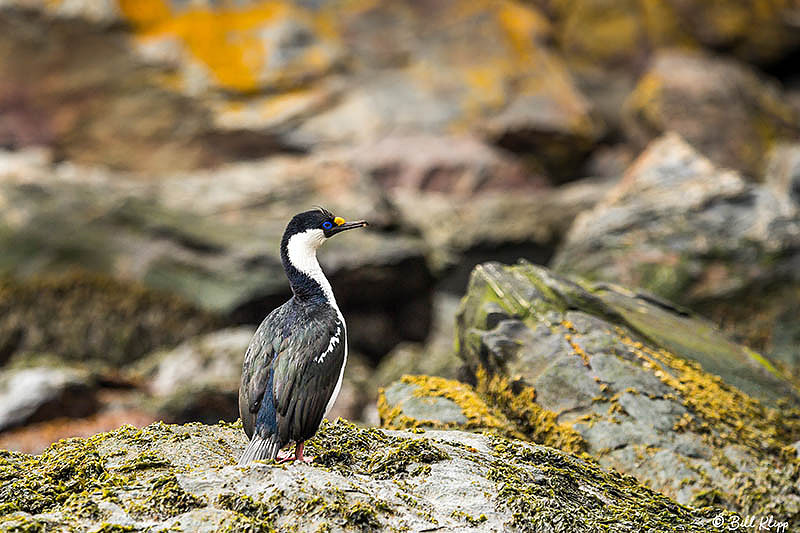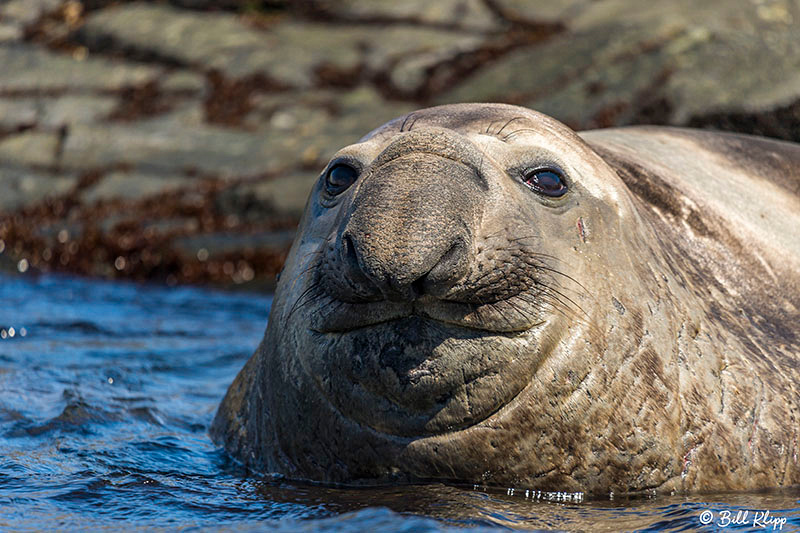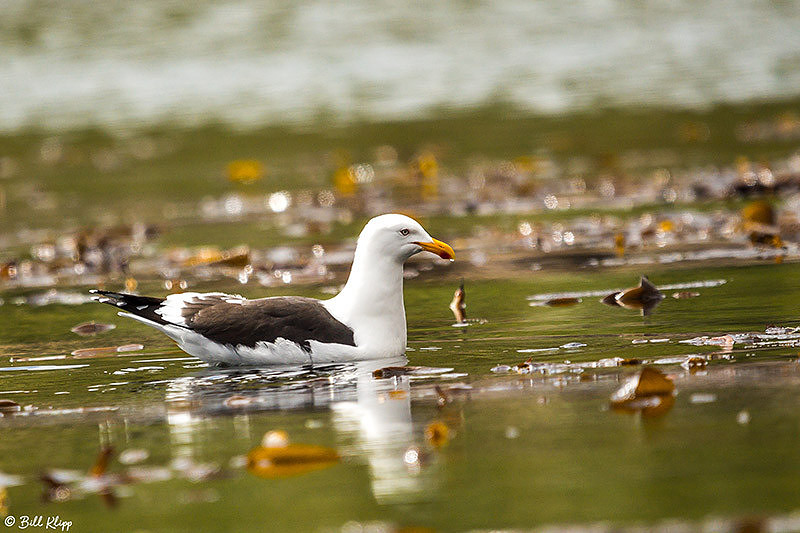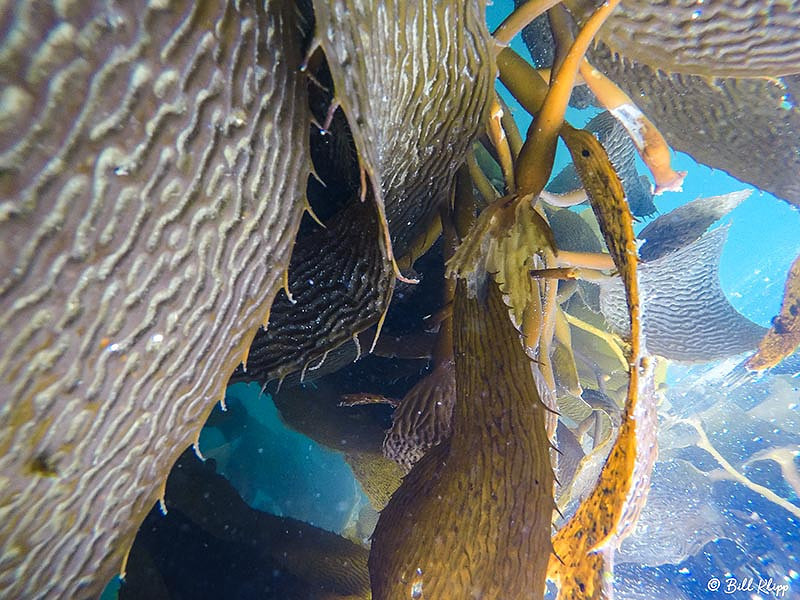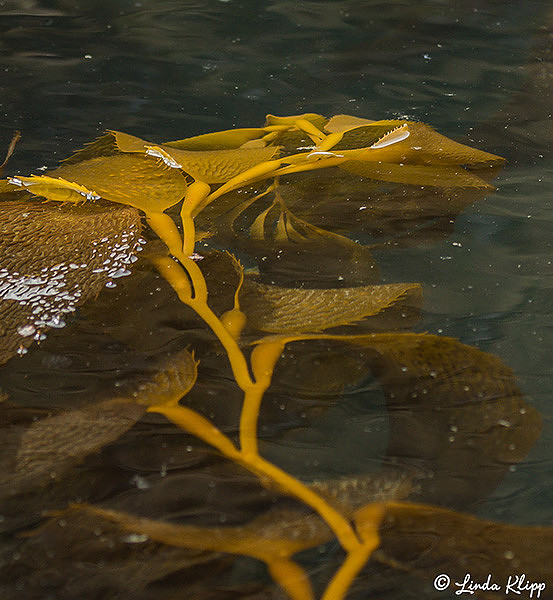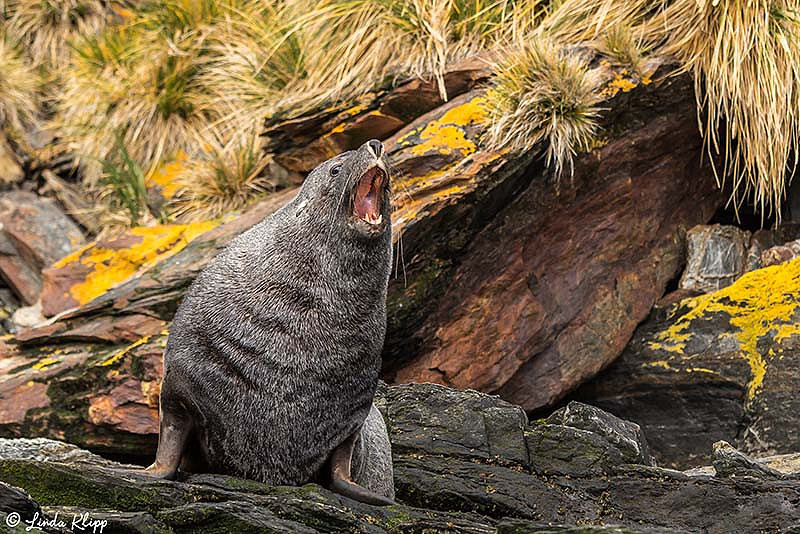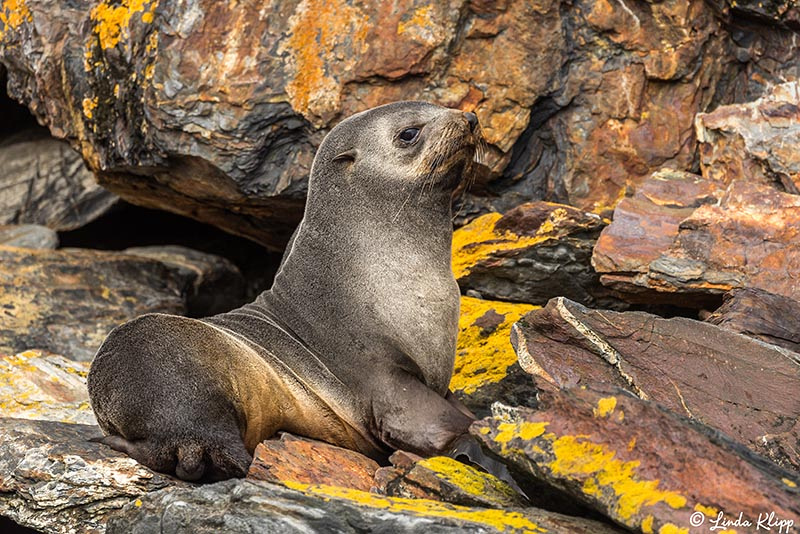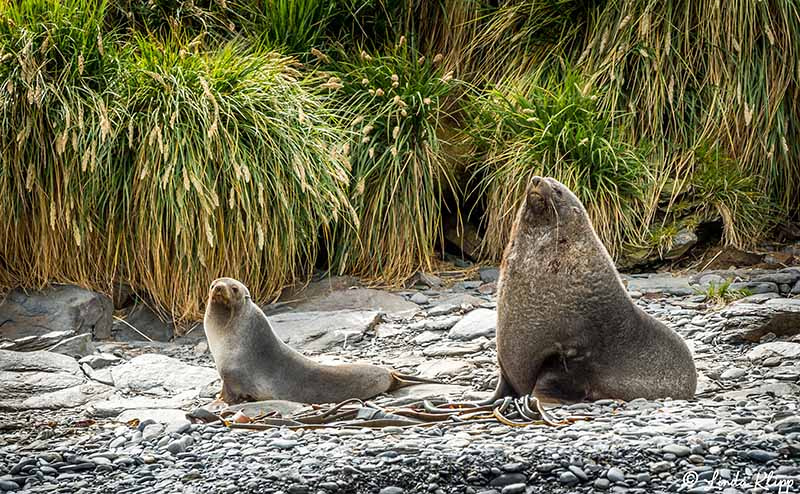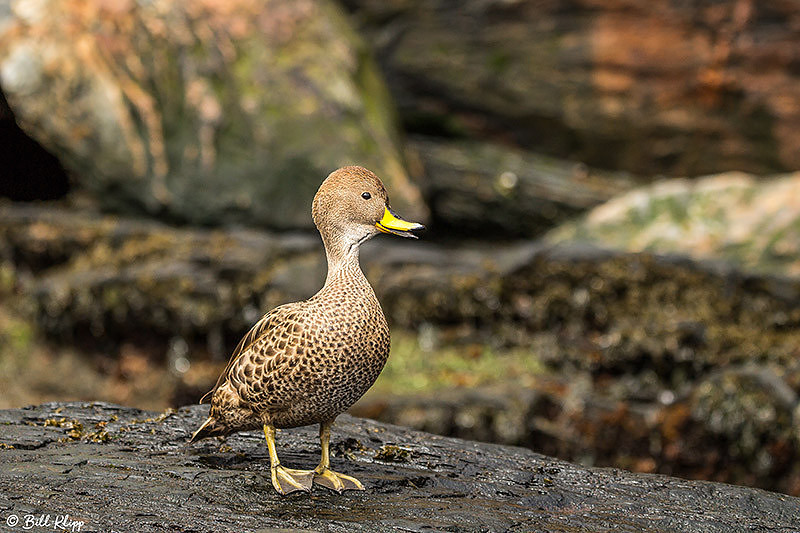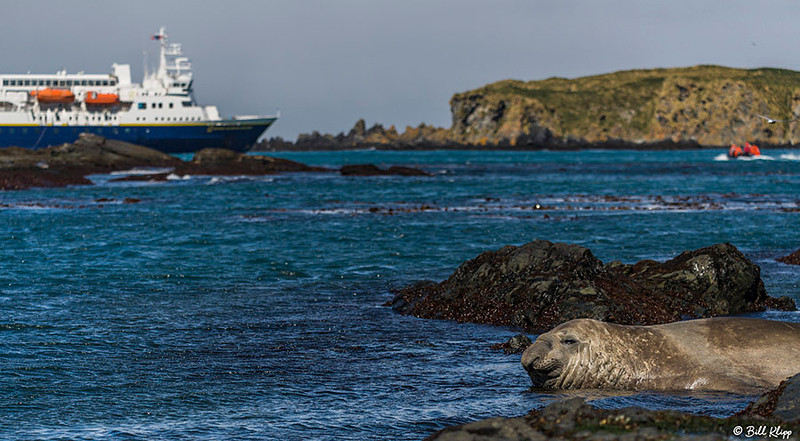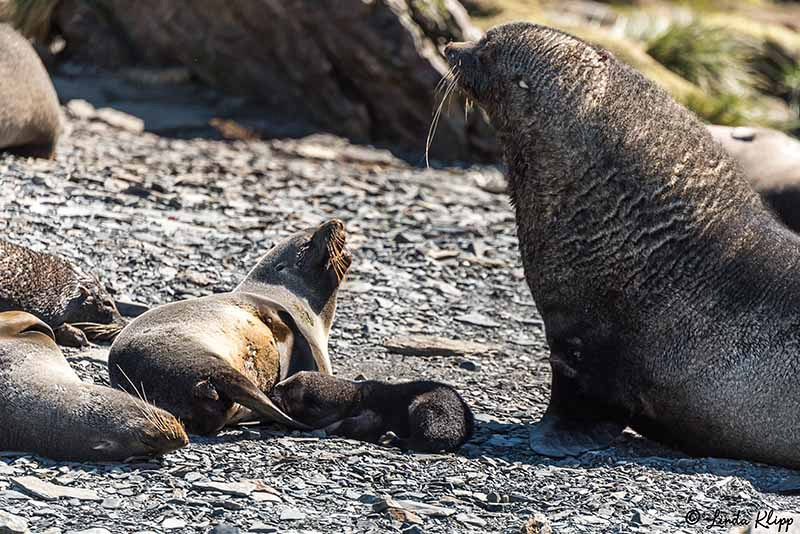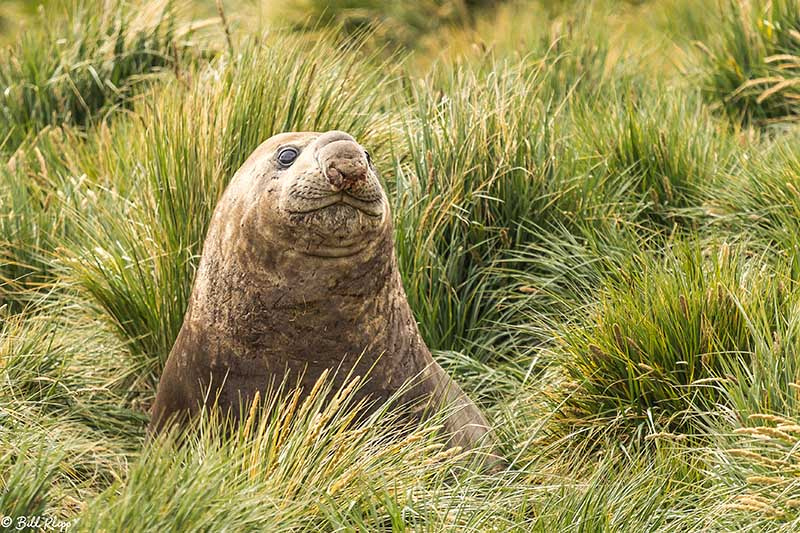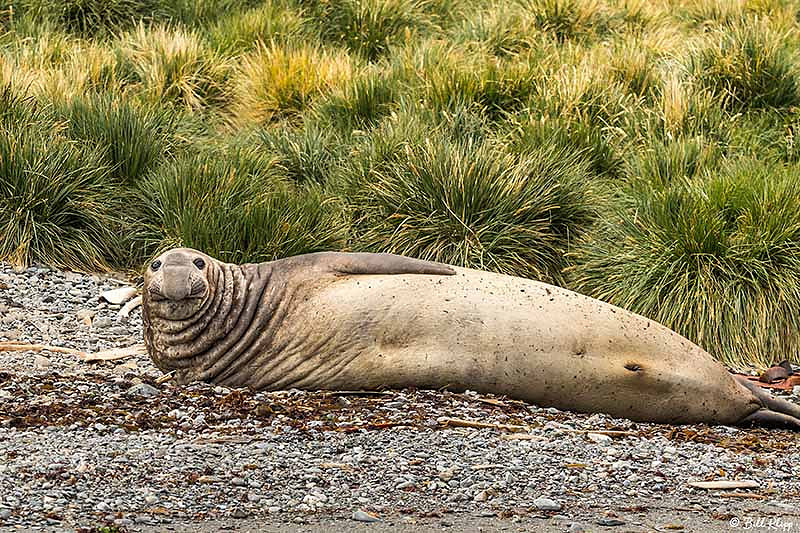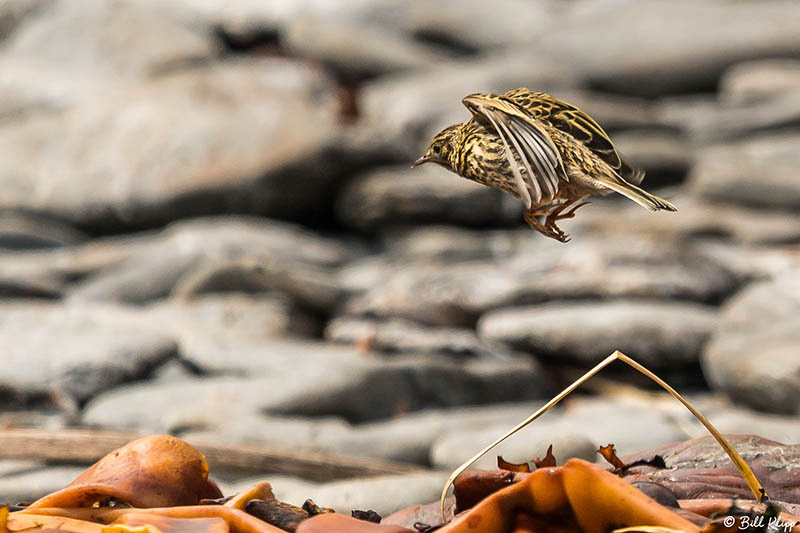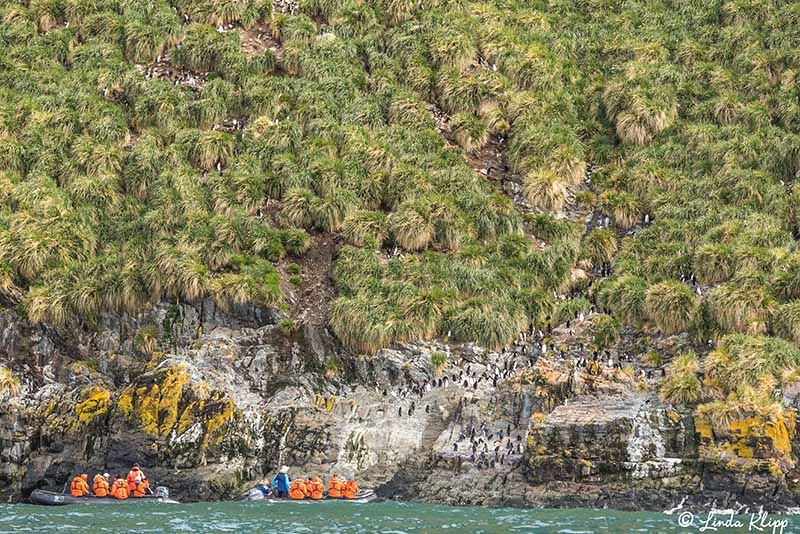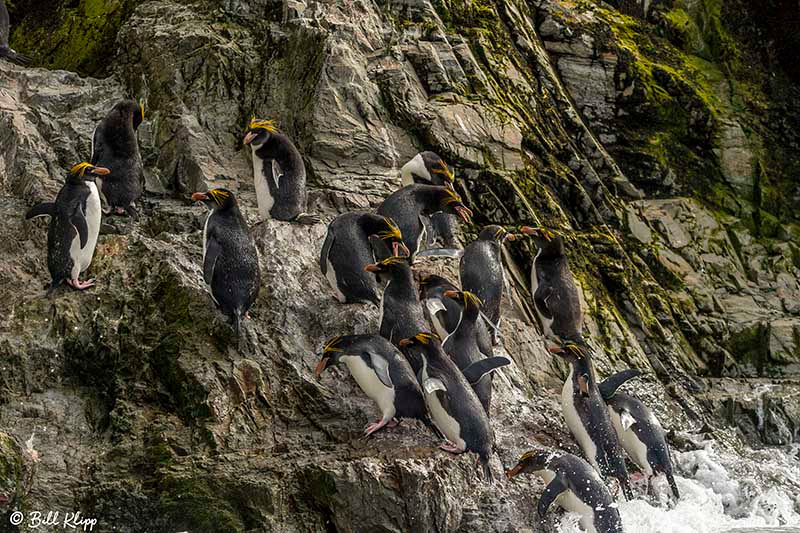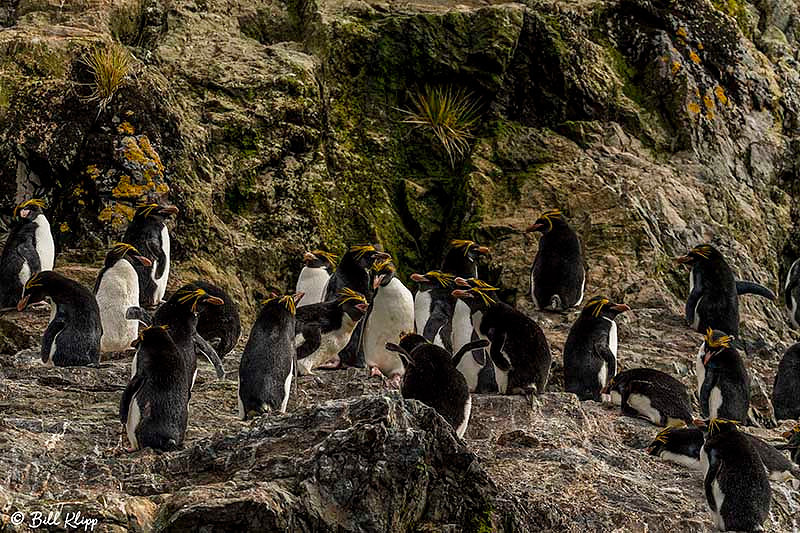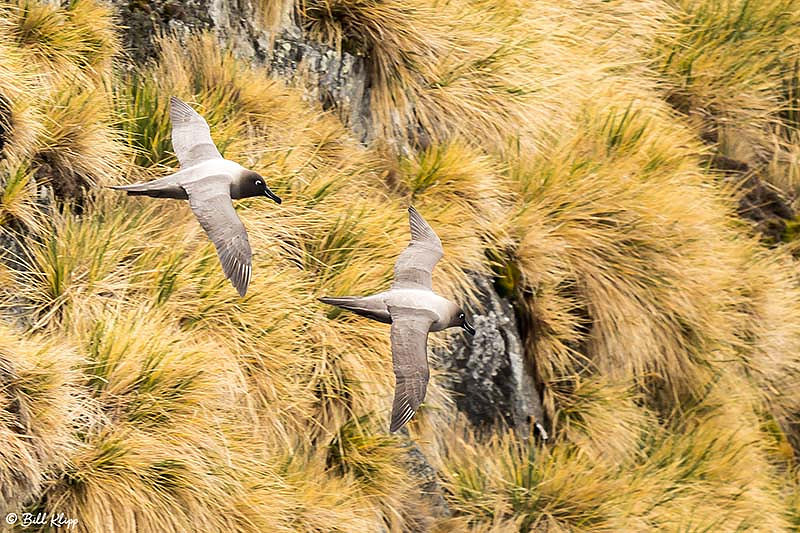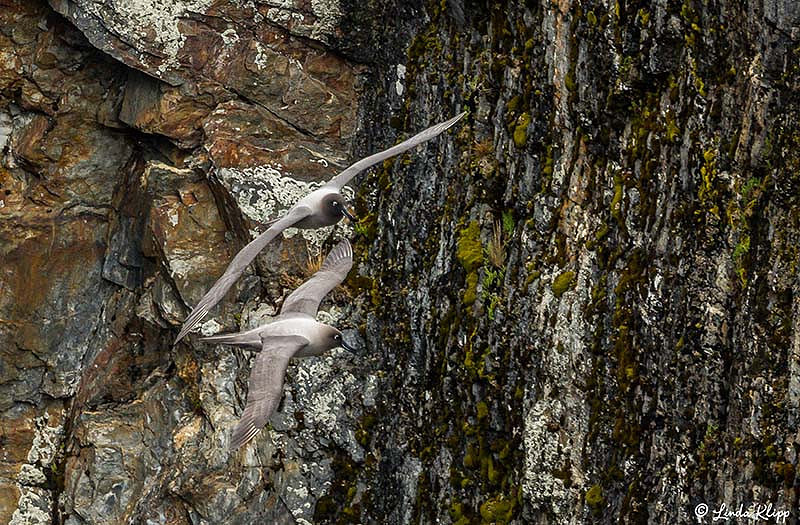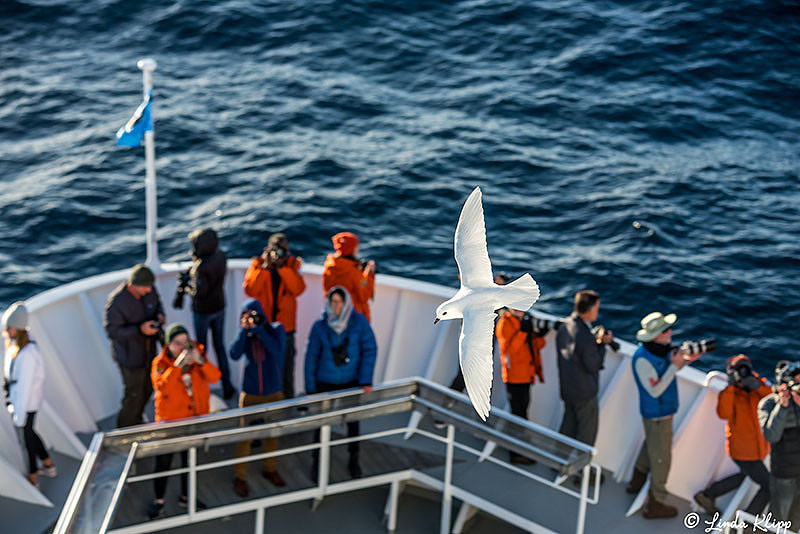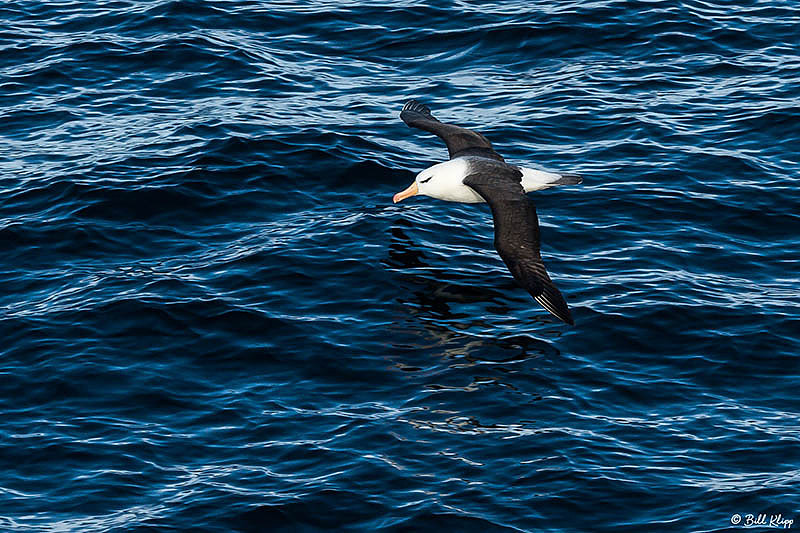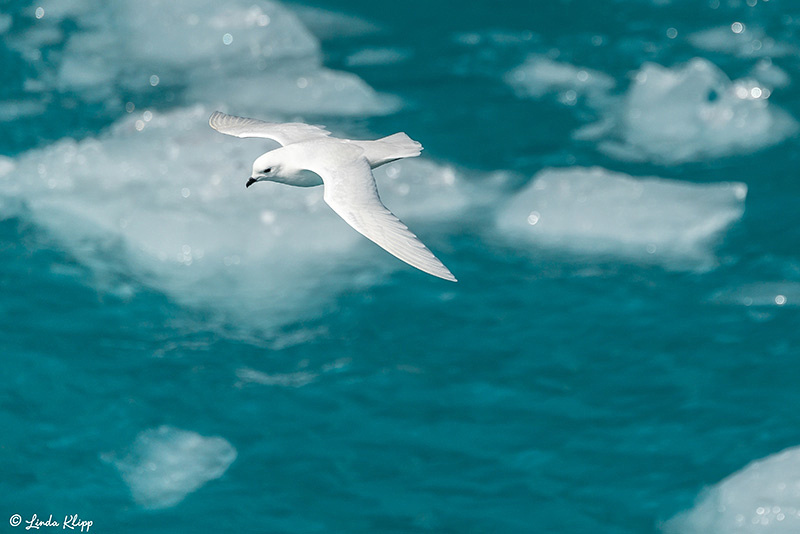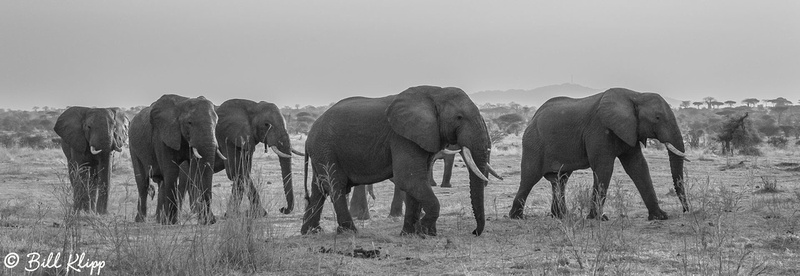


Antarctica Wanderings III – Nov 2017, “South Georgia Island Part 1”
(Part III of "Antarctica Wanderings" highlights South Georgia Island Part 1)
After our visit to the Falkland Islands our next landfall on the way to Antarctica was South Georgia Island and the South Sandwich Islands South Georgia Island is easily one of the most incredible places on the planet for its scenery and abundance of unusual wildlife. It is a very remote crescent shaped island that is about 120 miles long and located about 1,000 miles south east of Cape Horn (tip of South America). The only way to get here is by boat as there are no landing strips, towns or hotels and it is too far from anywhere to come by helicopter. No large cruise ships allowed here and there is no permanent human population. It is a very rugged island with 9,000 foot peaks and Himalayan like typography interlaced by hundreds of glaciers. It has often been described as Switzerland meets the ocean. South Georgia was an British colony discovered by Captain Cook. It now has its own governing body located in Stanley, Falklands and is part of the United Kingdom. It is located below the Antarctic Convergence so its weather patterns are heavily influenced by Antarctica but unlike the very dry and desert environment of the Antarctic Continent (the driest continent) it gets 300- 360 days of precipitation with very actively changing and extreme weather patterns. It is common to experience katabatic winds of over 120 knots coming down over the tops of glaciers to the sea with almost no warning.
A cold rainy morning at Gold Harbor, made for some challenging photography.
A highlight for sure was our interactions with the Elephant Seal Weaners. All you had to do was find a curious fellow and sit down in the sand and the Weaner did all the rest. We are not allowed to touch them but if you sit quietly and leave it up to them, magical things sometimes happen.
South Georgia Island The government of South Georgia derives most of its income from issuing commercial fishing permits and from the roughly 6,000 tourists that make their way down here. On the island itself are two British research stations, a couple of research shacks / camps, a few emergency supply shacks and the remnants of old whaling stations from the early 1900s. Located at the Grytviken research station is the remains of a historic whaling station, a small museum, post office, a little church and conservation office. Also there is an old cemetery where Ernest Shackelton is buried. There are only a few people who live here with the 30 million sea birds and very large numbers of marine mammals such as Elephant Seals, Sea Lions, Fur Seals with several varieties of Whales in the nearby waters. The marine mammals come here each spring and summer to give birth and mate before heading back to sea for the rest of the year. At the peak in Nov / Dec over 4 million Fur Seals will arrive. There are no indigenous terrestrial mammals and no trees but 25 types of small low lying plants along the coast. Like Antarctica, South Georgia is governed by IAATO, the International Association of Antarctica Tour Operators which establishes very rigorous rules and standards for any visitors. All visitors must receive a mandatory briefing and certification before stepping upon the island. In addition all of our outerwear (boots, jackets, hats, gloves, rain pants, tripods, walking sticks, backpacks, etc) must be decontaminated before each visit.
A group of Prions shot in the rain from our Zodiac
So why go here? The answer is: This is THE PLACE to go to experience the greatest density of wildlife on the planet; 7 million Penguins across 6 species, 95% of the world’s Antarctic Fur Seal population, 50% of the world’s Southern Elephant Seal population and over 250,000 Albatross across a variety of species to name just a few of the creatures who visit this remote place.
A King Penguin Colony sprawling up the mountainside at Right Whale Bay
We made excellent progress crossing the Scotia Sea from the Falklands so we started our visit to South Georgia earlier than expected and our 1st visit will be to Elsehul & Right Whale Bays, two new places for Linda and I. Overall the weather today was miserable, temps in the high 30s with strong winds driving the rain sideways. But if you don't go outside you see anything and you never know if today will actually be better than tomorrow, so off we go every day regardless of conditions. At Elsehul Bay our zodiac plowed thru the choppy wind blown seas and driving rain while we explored the fog shrouded shoreline where we found some Fur Seals, sea birds and a Gentoo Penguin colony. In the afternoon we had our first shore landing in the driving rain at Right Whale Bay a small bay with stunning scenery and a small King Penguin colony interspersed with male Fur Seals claiming their territories for the breeding season. Small is a relative term here, when I say small penguin colony that means thousands of animals vs tens or hundreds of thousands. The windy, rainy conditions were pretty tough and this would be our weather conditions for the next several days and the next few days took a toll on a lot of guests as over a dozen cameras did not hold up to the wet conditions creating many equipment failures. Having said that some of our best shots are during inclement weather. Never the less we powered through several days of miserable weather only to be rewarded with a bunch of beautiful sunny blue-sky days for much of the rest of the trip.
Grey Headed Albatross
Macaroni Penguins Headed back up the cliffs to their Eleshul Bay colony
Macaroni Penguins returning from a foraging trip
Fur Seals on beach at Eleshul Bay, shot from zodiac
Gearing Up Each time we head out to a landing we need to gear up. It took us a few days to get it right but now we have our system down pat and can be ready in 15 minutes. The key is layering as the weather down here changes rapidly. We also need to make sure both our equipment and self are waterproof from head to toe, as we seem to encounter water in some way every day whether it be rain, mist, snow or ocean spray coming over the sides of the zodiac. While our trip started in the Falklands with temps in the mid 40s, in South Georgia we were often in the mid to high 30s and when we get to Antarctica we will mostly be in the high 20s and low 30s (we hope anyway). In any case it often feels colder with the high winds and moisture. So each day on the bottom we don long underwear, covered by fleece pants and Gortex rain pants. Our uppers are the most variable depending on expected conditions and length of hikes, with the norm being a wicking type technical long sleeve shirt, under a cotton long sleeve shirt and maybe with a fleece vest or jacket. Over that we either use a Gortex type wind breaker (for the warmer Falklands) or the Lindblad supplied winter parka when it’s colder. Gloves are a personal item, I use thin light fleece gloves while Linda goes heavier with a liner and waterproof pair. Key is being able to work the controls on your camera. On our feet we wear hiking or ski type socks with hiking shoes (Linda often wears her Uggs) covered over with knee high water proof over shoes, along with our kneepads of course. Our feet are the most important as we always seem to be in the water, whether that be from the wet landings, shoreline surf or crossing streams, creeks and bogs. We keep our camera gear and other equipment in water proof backpacks and bags as water, in particular salt water is certain death to electronic components. We also carry giant zip lock bags for an emergency. A number of guests this trip are having camera equipment failures from the moisture.
Zodiac landing at Right Whale Bay
Zodiac Operations Unless we are at a port city all excursions off the ship are via Zodiacs which enable us to access landings not available to other vessels. Traveling from ship to land via Zodiac is an experience in itself. Each time we leave the ship we must wear a life jacket and check out with an electronic key card, one of two ways they make sure no one is left ashore. The Zodiacs pull up to the side of the ship and we step out of a hatch into them. This could be tricky and timing is critical, as the swells drop the zodiac up to 10 feet below you and as the waters rise you actually step up to get in. In the environmental areas of South Georgia and Antarctica we decontaminate our boots as we leave the ship and rinse / hose down when we return. Once on shore we leave our life jackets in bins at the landing site so they can better account for us at departure. Since we left the Falklands all our landings have been wet in that the zodiacs are driven to shore and we need to jump out into shallow water on usually sandy or pebbly / rocky bottoms. The Zodiacs are about 18 feet long and carry 8-12 people. They usually pull into shore bow first but with waves or swells they might stern in first. Depending on conditions there will be between 2 and 8 staff in the water wearing chest wader’s to catch and secure the zodiac as we disembark. We then unload by always facing the seas watching the waves, than when the timing is right you swing your legs over the side hopping into the water with your gear. The staff of course will help anyone needing it. Getting back in is basically the process in reverse. Most times this is not a problem but some landings can be both tricky and a bit crazy as the zodiac can get pummeled with waves while you are trying to get out or in. On occasion someone will fall in requiring a quick return to the ship.
King Penguin at Right Whale Bay, notice the seal skulls
"As I laid on the ground to shoot some Penguins I felt something pecking on my feet". It was a Snowy Sheathbill which we affectionately call a "Shitbill" as they are often found eating Seal and bird shit.
A large group of molting King Penguins huddling together in the rain
Got to love the breeding colors of King Penguins
Two King Penguins and a Snowy Sheathbill on beach at Right Whale Bay
A Trident to help push back the very aggressive Fur Seals
Male Fur Seal taking the high ground on a tussock
We were very excited when we heard our next South Georgia landing will be at Gold Harbour a place we have been several times on past trips. When I think Gold Harbour, I think of a relatively small bay, walled by spectacular snow covered mountains interlaced with glaciers fronted by a black lava sand beaches covered with groups or harems of thousands of breeding Southern Elephant Seals and a large breeding colony of King and Gentoo Penguins. Gold Harbour is one of the most scenic and amazing places on the planet. As we approached the shoreline it was clear this visit would be difficult, we were met with temperatures in the mid to high 30s F with high winds and constant rain, not the best conditions to be cruising in zodiacs and wandering the beaches and tussock grass covered mountain sides in search of awesome wildlife photographs but we persevered and got some good shots in spite of what was really a normal day in South Georgia. We luckily came back to Gold Harbor on our last day and were met with beautiful blue skies.
Southern Elephant Seal bellowing to to chase a competitor away
About King Penguins Gold Harbor is a breeding rookery for King Penguins and since it is still early in the season many sub-adults were molting (shedding their feathers to grow a new coat) so it was not yet time to mate and lay eggs. In addition, the entire beach was covered with Okum Boys which are 9 month old King Penguin chicks born late last summer (Feb / March). They spend the winter here with their thick fluffy brown coats and will be ready to fledge and begin swimming before this coming winter. If they don’t mature by this time they are not able to survive a second winter and we saw evidence of this with many dead chicks along the beach. These chicks were originally thought to be a different species of birds since they look so different from the adults. In fact, they are even larger and heavier than the adults as they have had to fatten up to survive the winter. They can’t yet swim as their fluffy coats are not water proof. The source of their name Okum Boys goes back to the Whaling and Sealing days as young boys were hired to climb down into the hold of the whaling ships to install a mixture of Okum and horse hair between the ship’s wooden planks to seal the hull. When they came out they were all brown and looked tarred and feathered. These not so little pudgy Penguins are incredible to watch, they have a ton of personality. They usually gather together in huge crowds to stay warm and they have a real friendly and curious streak to them. All you need to do is sit down quietly near the group and several will wander over to check you out. They will walk right up to you and peck your boots or tripod. Then all of a sudden one would get all excited and run around flapping its wings, squawking, whistling, falling down or bumping into the others. You can watch them for hours as they make you constantly smile and laugh.
The young King Penguins have no fear of us and are very curious
Brown Skua has no fear
Gentoo Penguins taking to the surf
The Giant Petrel is a key predator in the Penguin Colony
This Brown Skua seemed to like it's reflection in Linda's camera lens
Elephant Seal pups known as weaners. These guys are fully weaned by their mom within 3 weeks then left to fend on their own.
Mom with her chick
To our surprise and delight due to the time we gained by flying into the Falklands vs sailing we will return to Gold Harbour on our last morning in South Georgia and be met with beautiful morning light and sunny blue skies, an amazing contrast from today. But I'm actually liking some of our rainy day photos better.
King Penguins returning from a fishing trip emerging from the surf onto Gold Harbour Beach
A big bull on the move to protect his harem
Elephant Seal pups known as weaners, play fighting
These pups can almost speak to you with their amazingly big eyes
This young male doesn't yet have his own harem, but has some battle scars from attempts to win one
The Sights & Sounds of Gold Harbor, Click this link for Youtube video: Linda's Gold Harbor Video
About Elephant Seals There are two species of elephant seals, the Northern and Southern. Most of us are familiar with the Northern Elephant Seals found in California and Baja California, and while we think these guys are big they are nothing compared to their Southern cousins. Southern Elephant Seals live in sub-Antarctic and Antarctic waters that feature brutally cold conditions but are rich in the fish, squid, krill, and other marine foods these seals enjoy. Southern Elephant Seals breed on land but spend their winters in the frigid Antarctic waters near the Antarctic pack ice. Unlike their somewhat smaller cousins in the North, Southern Elephants are the largest of all seals, males can be over 20 feet long and weigh up to 8,800 pounds, the size of pickup trucks. Females while large grow to about 12 feet and can weigh as much as 2,000 pounds. These massive pinnipeds aren't called Elephant Seals because of their size, they take their name from their trunklike inflatable snouts.
In late Aug / Sept the male Elephant Seals arrive on the beach to claim a territory, then they mostly lay around on the beach for a month or so not eating just guarding his territory from other males and hoping to collect a harem of 15 to 50 females. He spends his days and nights guarding his women and trying to mate as many times as he can. The constant fighting, defending of territories and mating is exhausting for them so the dominate males are usually the biggest and strongest of the all. The males battle each other almost constantly for mating dominance. Some encounters end with roaring and aggressive posturing, but many others turn into violent and bloody battles.
We called these big beach master males "Harvey", as sexual harassment seemed to be their main preoccupation
One way to cool down and avoid sunburn is to cover yourself with sand
Always very curious checking out our stuff, right before he knocked over the camera
Click above photo for video: Linda’s Elephant Seal Encounter You would never guess that sitting on the beach in the rain when it’s a chilly 37 degrees could be a fun experience. Well sometimes that can happen on the magical beaches of South Georgia Island.
These big guys move surprisingly fast and silently. They are not aggressive to us at all, but when one of them wants to go from A to B you better not be in their way or they will run right over you
Elephant seals migrate in search of food, spending months at sea and often diving deep to forage. They have been known to dive to over 7,800 feet below sea level and stay down for over an hour, an amazing feat of physiology for a mammal. The females arrive in Sept / Oct to give birth and mate before heading back out to sea. The mothers suckle their young for only 2-3 weeks during which they put on about 20 pounds per day due to the incredibly high fat content of the milk. While suckling their young, females do not eat—both mother and child live off the energy stored in ample reserves of her blubber.
Are these guys cute or what?
A male Elephant Seal surrounded by the females of his harem. Our ship the National Geographic Explorer in the background
Godthul Harbour was another new spot for us with it's glacial head wall forming a natural cliff amphitheater. We did some zodiac cruising here and found a large variety of sea birds
Blue-Eyed Shag, is a type of Cormorant
The Kelp Gull is the only Gull found here
We sometimes had a hard time maneuvering in the zodiac due all the kelp
Male Fur Seal, during breeding season these guys are very territorial and can be vicious
Female Fur Seals are much smaller than the males
Side by side one can easily see the sexual dimorphism of male and female Fur Seals
This cute little South Georgia Pintail Duck is actually a carnivorous duck, don't get too close
Fur Seal with nursing pup only a few days old. Notice how much bigger the males are
The South Georgia Pipit, the southernmost songbird has had an amazing comeback. Back in 2011 when we were last here this bird was facing near extinction and was only found on a few out islands. There are no trees in South Georgia so the Pipit like most birds here nest on the ground. As a result their population on the main islands was decimated by invasive rats introduced to the island back in the whaling days. Six ago an ambitious project was launched to rid the entire island of rats. The largest project of its kind ever attempted and now there are Pipits popping up everywhere as the rats have been exterminated. The Project was an amazing success. Back in 2011 we made a donation by purchasing several 6 hectors of land for rat eradication, it was nice to return and hear about the success of the project.
Hercules Bay is a nice protected bay and a good spot to see the hardy little Macaroni Penguins as they emerge from the sea and make their way high up the rocky cliffs to their colony in the tussock covered slope overlooking the bay. The high seaside cliffs here make a good spot for many other species of birds that breed in the area. Overhead one will see gulls, Terns and Light-Mantled Albatross. Being a fjord there was no place for us to land as the coastline was sheer cliffs. So this morning’s activity was a zodiac cruise around the fjord taking in the sights.
Hercules Bay seems to be favorite place for the hardy little Macaroni Penguins, in spite of the steep rugged shoreline
Macaroni Penguins
Light-Mantled Albatross nest high in the cliffs and perform a mating ritual where the male and female take to the skies for a synchronized acrobatic flight, its beautiful to watch.
Snow Petrel over the ship's bow
Black Browed Albatross
Snow Petrel
Risting tidewater Glacier in Drygalski Fjord, South Georgia The ship headed to the protected Drygalski Fjord, with its tall steep cliff walls and narrow waterway, it's a beautiful and classic fjord setting. We sailed deep into the fjord which dead ends at Risting Glacier the largest coastal glacier in South Georgia. Shortly after this photo was taken there was a deep rumble as a “Shooter” emerged from the sea. A "Shooter" (at least in Antarctica) is the calving of a Glacier from under the sea, creating an iceberg that lunges to the surface like a giant cork spreading ice chunks everywhere and creating a wave. Click above photo to see video of a small Shooter
Don't miss our next blog installment of “Antarctica Wanderings IV” where I continue to share images in Part 2: South Georgia Island Part 2
For more photos visit Bill & Linda's photo website: http://WildlifePhotos.me © Bill & Linda Klipp 2017, All Rights Reserved Check out our online Photo Website at: http://www.wkimages.net & http://www.videos.wkimages.net / * Any use of these images requires the prior written permission of Bill Klipp the photographer, no other uses of any kind including print or electronic are permitted without the prior written permission of the photographer. Comments
Stephen(non-registered)
Awesome pictures and videos
[email protected](non-registered)
Beyond amazing...thank you for sharing your adventure!
No comments posted.
Loading...
|
